数据结构与算法篇(刷题篇 - 链表)
目录
1. 反转链表(简单)
1.1. 题目描述
1.2. 解题思路
方法一:迭代(推荐使用)
方法二:递归(扩展思路)
方法三:使用栈解决
方法四:双链表求解
2. 链表内指定区间反转(中等)
2.1. 题目描述
2.2. 解题思路
方法一:头插法迭代(推荐使用)
方法二:递归(扩展思路)
3. 链表中的节点每k个一组翻转(中等)
3.1. 题目描述
3.2. 解题思路
方法一:递归(推荐使用)
方法二:模拟法
4. 排序链表(中等)
4.1. 题目描述
4.2. 解题思路
方法一:自顶向下归并排序
方法二:自底向上归并排序
5. 合并两个排序的链表(简单)
5.1. 题目描述
5.2. 解题思路
方法一:双指针迭代(推荐使用)
方法二:双指针递归(扩展思路)
6. 合并k个已排序的链表(较难)
6.1. 题目描述
6.2. 解题思路
方法一:归并排序思想(推荐使用)
方法二:优先队列(扩展思路)
7. 判断链表中是否有环(简单)
7.1. 题目描述
7.2. 解题思路
方法:双指针(推荐使用)
8. 链表中环的入口结点(中等)
8.1. 题目描述
8.2. 解题思路
方法:双指针(推荐使用)
9. 相交链表(简单)
9.1. 题目描述
9.2. 解题思路
方法一:哈希集合
方法二:双指针
10. 环形链表II(中等)
10.1. 题目描述
10.2. 解题思路
方法一:哈希表
方法二:快慢指针
11. 链表中倒数最后k个结点(简单)
11.1. 题目描述
11.2. 解题思路
方法一:快慢双指针(推荐使用)
方法二:先找长度再找最后k(扩展思路)
12. 两个链表的第一个公共结点(简单)
12.1. 题目描述
12.2. 解题思路
方法:双指针
13. 链表相加(二)(中等)
13.1. 题目描述
13.2 解题思路
方法:反转链表法(推荐使用)
14. 两数相加(中等)
14.1. 题目描述
14.2. 解题思路
方法一:模拟法
15. 单链表的排序(中等)
15.1. 题目描述
15.2. 解题思路
方法一:归并排序(推荐使用)
方法二:转化为数组排序(扩展思路)
16. 判断一个链表是否为回文结构(简单)
16.1. 题目描述
16.2. 解题思路
方法一:数组复制反转法(前置知识)
方法二:数组复制双指针(前置知识)
方法三:长度法找中点(推荐使用)
方法四:双指针找中点(推荐使用)
方法五:栈逆序(扩展思路)
17. 链表的奇偶重排(中等)
17.1. 题目描述
17.2. 解题思路
方法:双指针(推荐使用)
18. 删除有序链表中重复的元素-I(简单)
18.1. 题目描述
18.2. 解题思路
方法:遍历删除(推荐使用)
19. 删除有序链表中重复的元素-II(中等)
19.1. 题目描述
19.2. 解题思路
方法一:直接比较删除(推荐使用)
方法二:哈希表(扩展思路)
20. 删除链表的中间节点(中等)
20.1. 题目描述
20.2. 解题思路
方法一:快慢指针
21. 删除链表的倒数第n个节点(中等)
21.1. 题目描述
21.2. 解题思路
方法一:双指针(推荐使用)
方法二:长度统计法(思路扩展)
22. 从尾到头打印链表(简单)
22.1. 题目描述
22.2. 解题思路
23. 两两交换链表中的节点(中等)
23.1. 题目描述
23.2. 解题思路
方法一:递归
方法二:迭代
24. 复制带随机指针的链表(中等)
24.1. 题目描述
24.2. 解题思路
方法一:回溯 + 哈希表
方法二:迭代 + 节点拆分
25. 链表最大孪生和(中等)
25.1. 题目描述
25.2. 解题思路
快慢指针+ 翻转链表(头部翻转)
1. 反转链表(简单)

1.1. 题目描述

1.2. 解题思路
方法一:迭代(推荐使用)
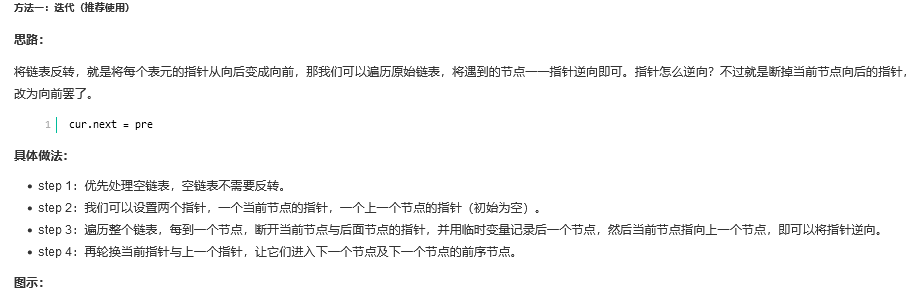
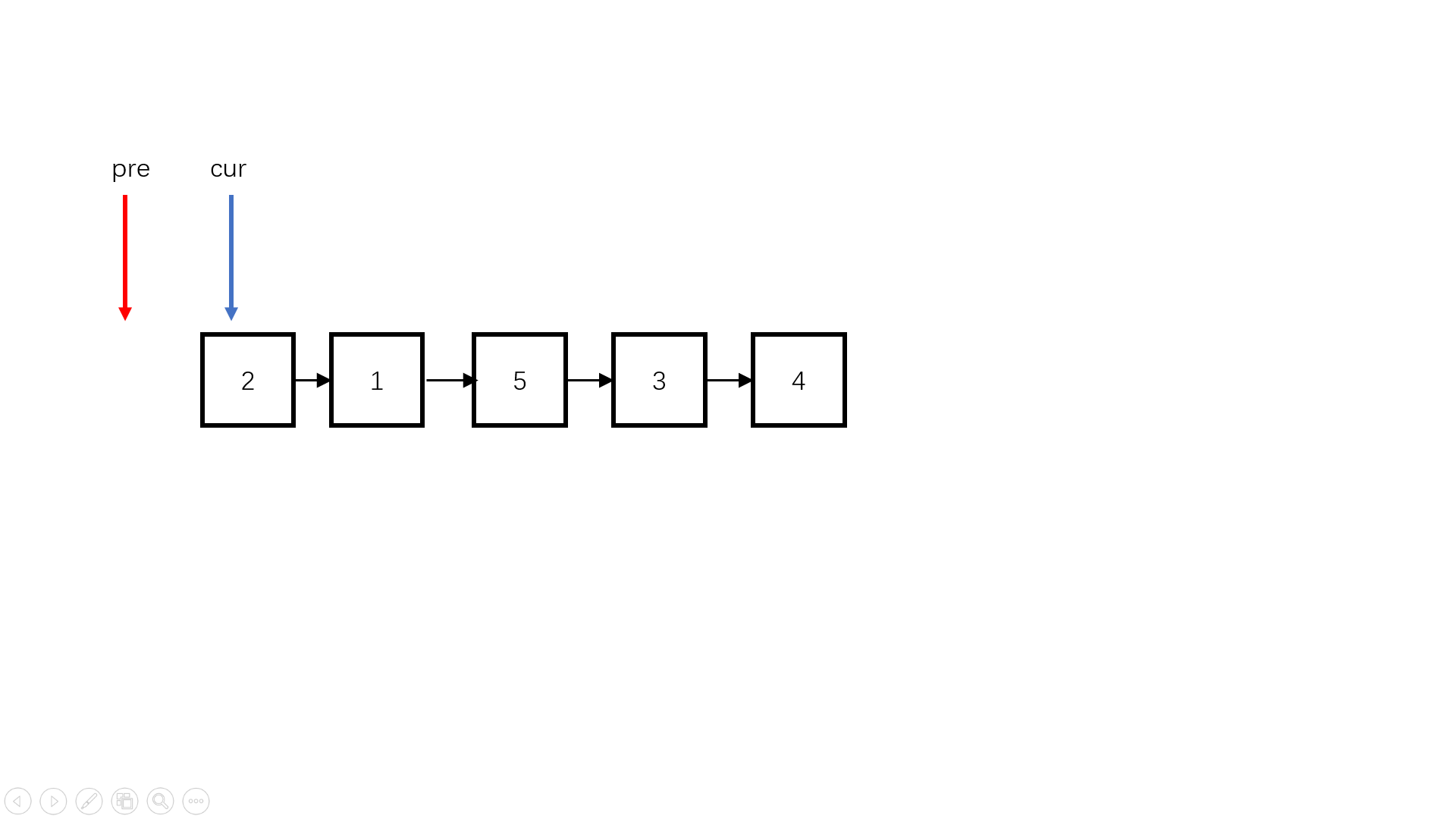
public class Solution {public ListNode ReverseList(ListNode head) {//处理空链表if(head == null) return null;ListNode cur = head;ListNode pre = null;while(cur != null){//断开链表,要记录后续一个ListNode temp = cur.next; //当前的next指向前一个cur.next = pre; //前一个更新为当前pre = cur; //当前更新为刚刚记录的后一个cur = temp; }return pre;}
}
方法二:递归(扩展思路)

public class Solution {public ListNode ReverseList(ListNode head) {//递归结束条件if(head == null || head.next == null)return head;//反转下一个ListNode newHead = ReverseList(head.next); //逆转本级节点head.next.next = head; //尾部设置空节点head.next = null; return newHead;}
}
方法三:使用栈解决
![]()
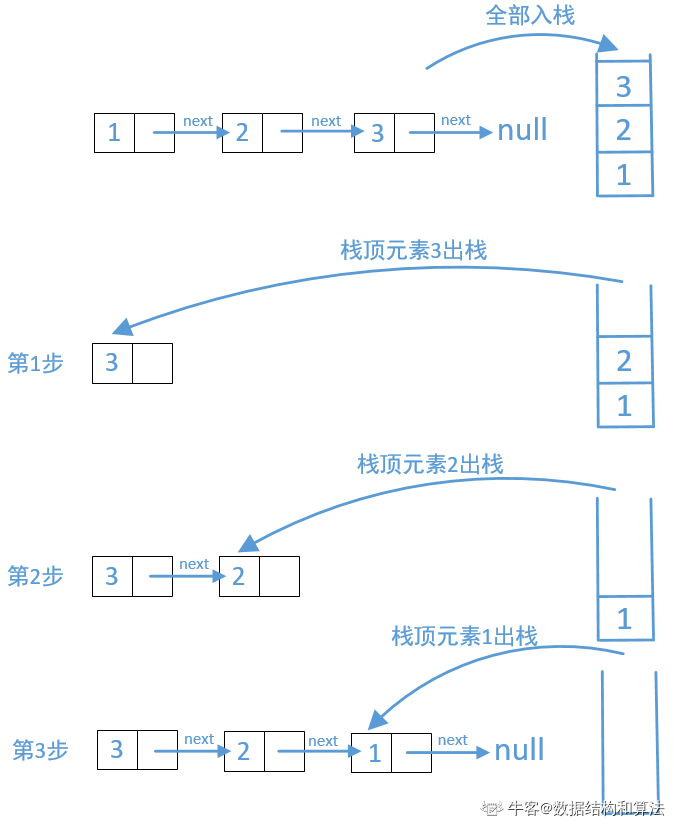
import java.util.Stack;
public class Solution {
public ListNode ReverseList(ListNode head) {Stack<ListNode> stack= new Stack<>();//把链表节点全部摘掉放到栈中while (head != null) {stack.push(head);head = head.next;}if (stack.isEmpty())return null;ListNode node = stack.pop();ListNode dummy = node;//栈中的结点全部出栈,然后重新连成一个新的链表while (!stack.isEmpty()) {ListNode tempNode = stack.pop();node.next = tempNode;node = node.next;}//最后一个结点就是反转前的头结点,一定要让他的next//等于空,否则会构成环node.next = null;return dummy;
}
}方法四:双链表求解

![]()
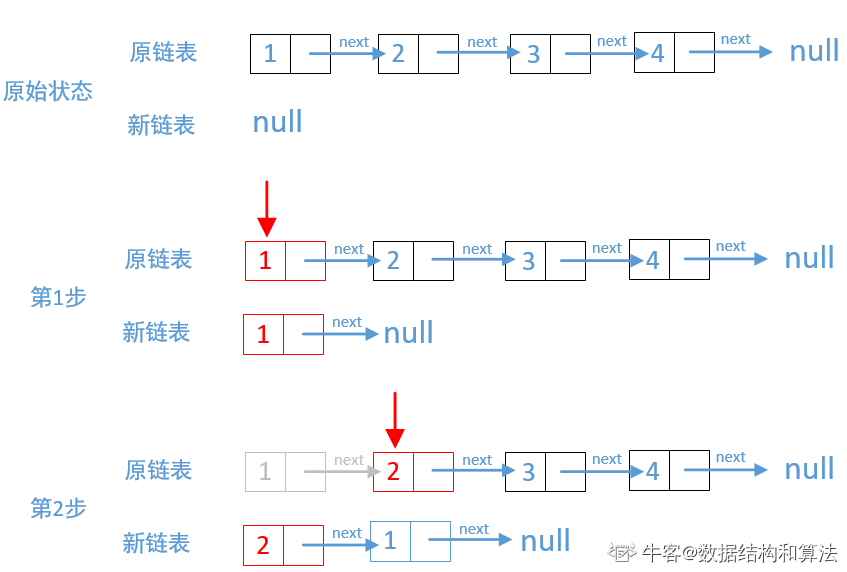
![]()
public ListNode ReverseList(ListNode head) {//新链表ListNode newHead = null;while (head != null) {//先保存访问的节点的下一个节点,保存起来//留着下一步访问的ListNode temp = head.next;//每次访问的原链表节点都会成为新链表的头结点,//其实就是把新链表挂到访问的原链表节点的//后面就行了head.next = newHead;//更新新链表newHead = head;//重新赋值,继续访问head = temp;}//返回新链表return newHead;
}2. 链表内指定区间反转(中等)
2.1. 题目描述
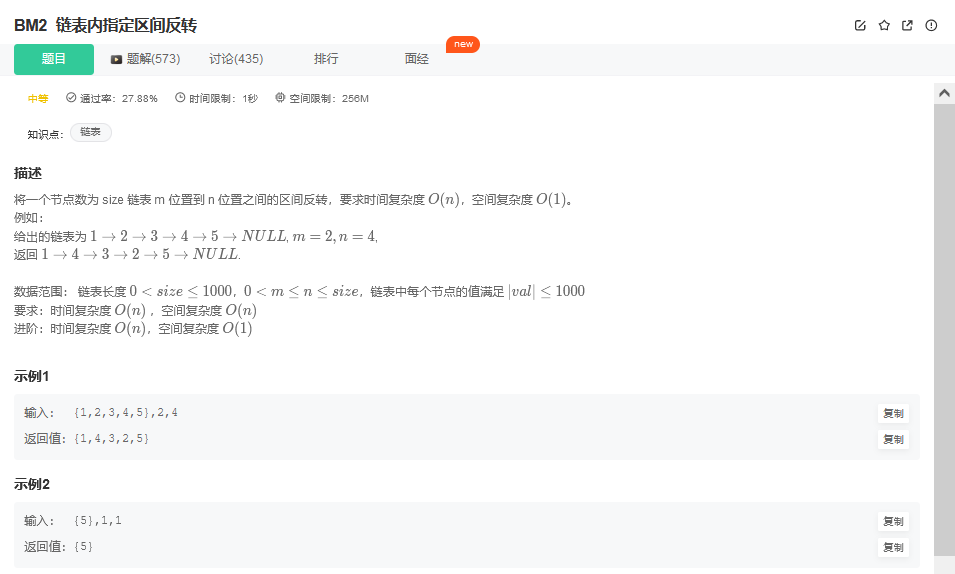
2.2. 解题思路
方法一:头插法迭代(推荐使用)
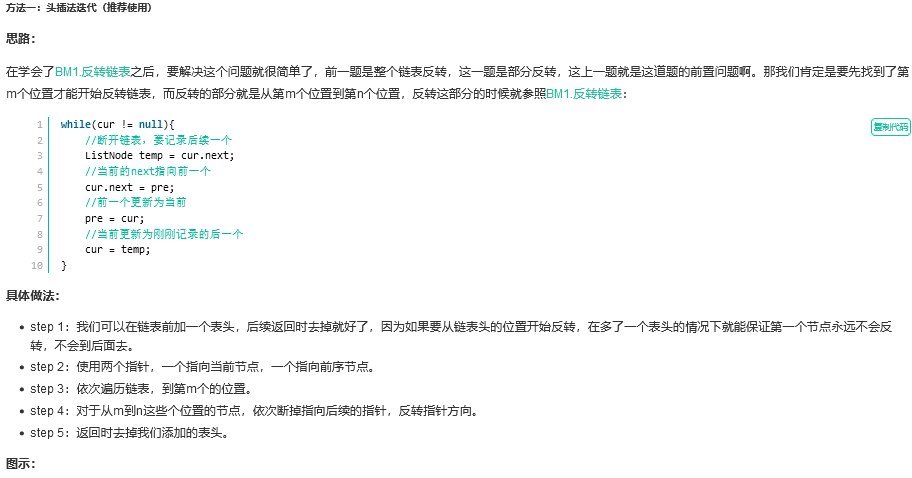
Java实现代码:
import java.util.*;
public class Solution {public ListNode reverseBetween (ListNode head, int m, int n) {//加个表头ListNode res = new ListNode(-1); res.next = head;//前序节点ListNode pre = res; //当前节点ListNode cur = head; //找到mfor(int i = 1; i < m; i++){ pre = cur;cur = cur.next;}//从m反转到nfor(int i = m; i < n; i++){ ListNode temp = cur.next;cur.next = temp.next;temp.next = pre.next;pre.next = temp;}//返回去掉表头return res.next; }
}

方法二:递归(扩展思路)

Java实现代码:
import java.util.*;
public class Solution {ListNode temp = null;public ListNode reverse(ListNode head, int n){//只颠倒第一个节点,后续不管if(n == 1){ temp = head.next;return head;}//进入子问题ListNode node = reverse(head.next, n - 1); //反转head.next.next = head;//每个子问题反转后的尾拼接第n个位置后的节点head.next = temp; return node;}public ListNode reverseBetween (ListNode head, int m, int n) {//从第一个节点开始if(m == 1) return reverse(head, n);//缩减子问题ListNode node = reverseBetween(head.next, m - 1, n - 1); //拼接已翻转head.next = node;return head;}
}


3. 链表中的节点每k个一组翻转(中等)
3.1. 题目描述

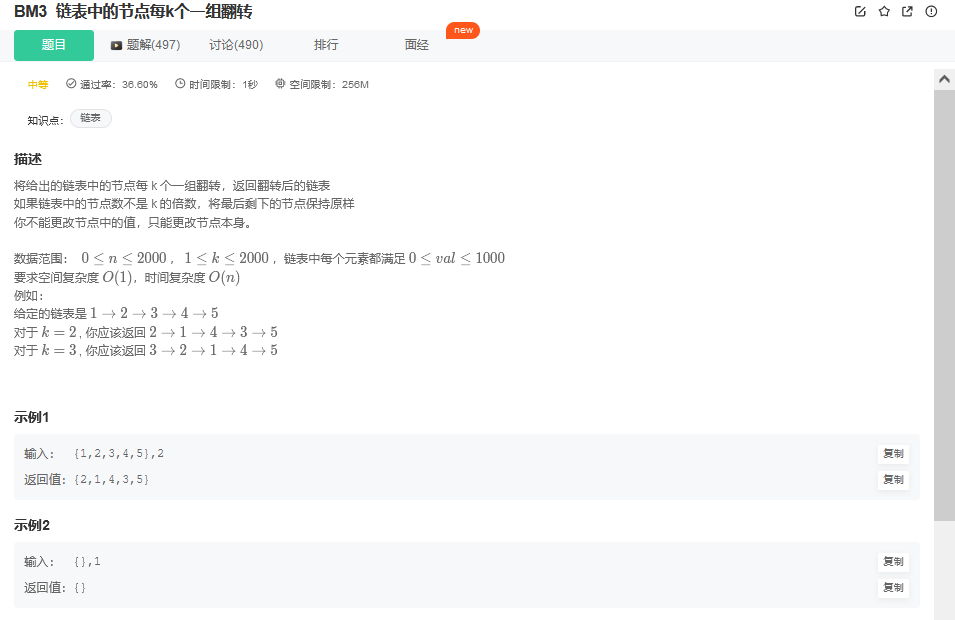
3.2. 解题思路
方法一:递归(推荐使用)

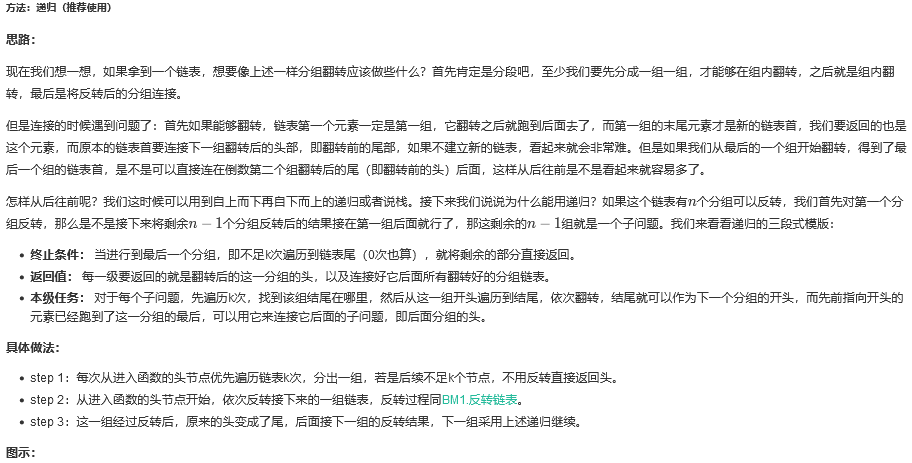
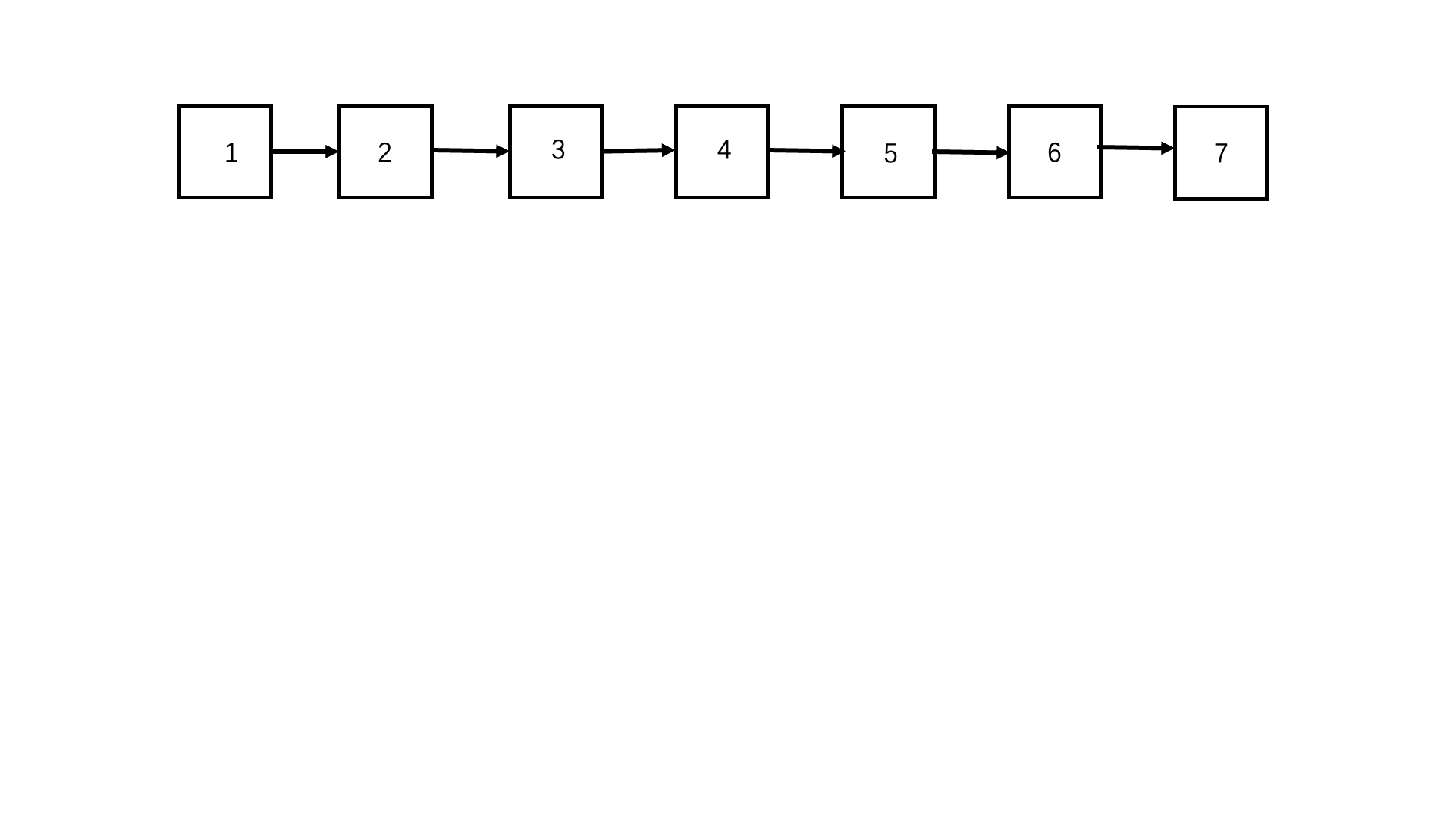
Java实现代码:
import java.util.*;
public class Solution {public ListNode reverseKGroup (ListNode head, int k) {//找到每次翻转的尾部ListNode tail = head;//遍历k次到尾部 for(int i = 0; i < k; i++){ //如果不足k到了链表尾,直接返回,不翻转if(tail == null) return head;tail = tail.next; }//翻转时需要的前序和当前节点ListNode pre = null; ListNode cur = head;//在到达当前段尾节点前while(cur != tail){ //翻转ListNode temp = cur.next; cur.next = pre;pre = cur;cur = temp;}//当前尾指向下一段要翻转的链表head.next = reverseKGroup(tail, k); return pre;}
}

方法二:模拟法

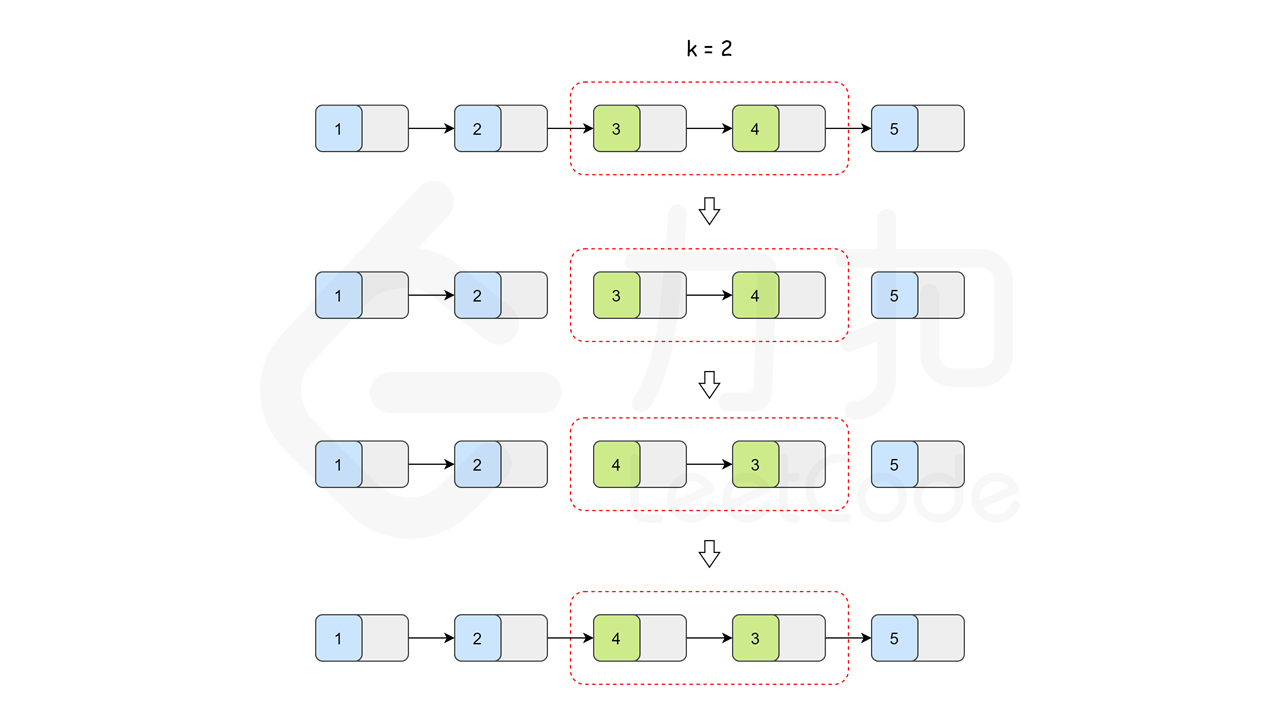

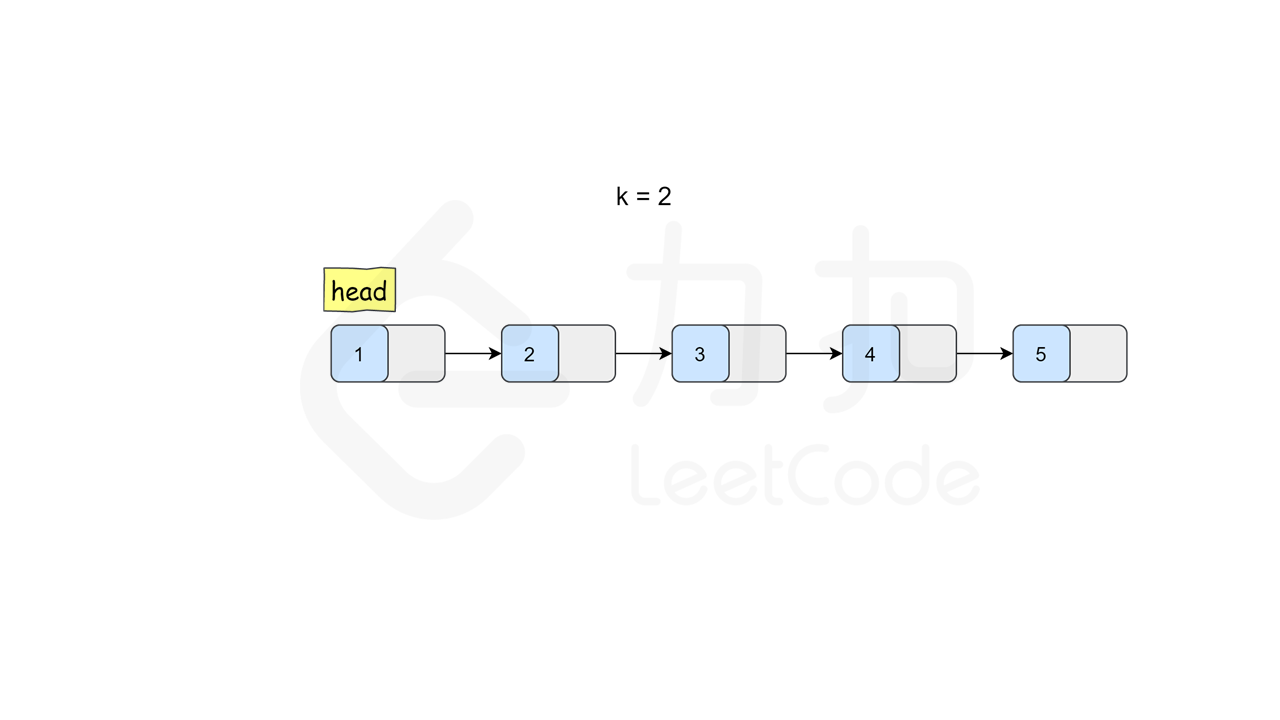
class Solution {public ListNode reverseKGroup(ListNode head, int k) {ListNode hair = new ListNode(0);hair.next = head;ListNode pre = hair;while (head != null) {ListNode tail = pre;// 查看剩余部分长度是否大于等于 kfor (int i = 0; i < k; ++i) {tail = tail.next;if (tail == null) {return hair.next;}}ListNode nex = tail.next;ListNode[] reverse = myReverse(head, tail);head = reverse[0];tail = reverse[1];// 把子链表重新接回原链表pre.next = head;tail.next = nex;pre = tail;head = tail.next;}return hair.next;}public ListNode[] myReverse(ListNode head, ListNode tail) {ListNode prev = tail.next;ListNode p = head;while (prev != tail) {ListNode nex = p.next;p.next = prev;prev = p;p = nex;}return new ListNode[]{tail, head};}
}

4. 排序链表(中等)
4.1. 题目描述

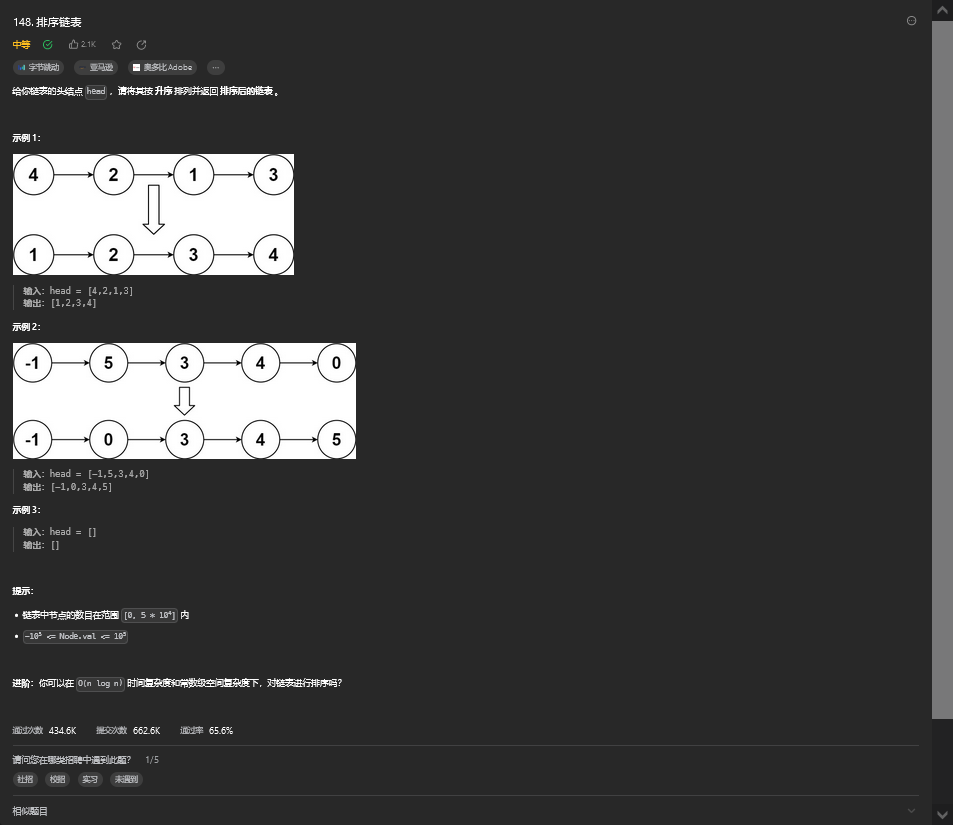
4.2. 解题思路
方法一:自顶向下归并排序


class Solution {public ListNode sortList(ListNode head) {return sortList(head, null);}public ListNode sortList(ListNode head, ListNode tail) {if (head == null) {return head;}if (head.next == tail) {head.next = null;return head;}ListNode slow = head, fast = head;while (fast != tail) {slow = slow.next;fast = fast.next;if (fast != tail) {fast = fast.next;}}ListNode mid = slow;ListNode list1 = sortList(head, mid);ListNode list2 = sortList(mid, tail);ListNode sorted = merge(list1, list2);return sorted;}public ListNode merge(ListNode head1, ListNode head2) {ListNode dummyHead = new ListNode(0);ListNode temp = dummyHead, temp1 = head1, temp2 = head2;while (temp1 != null && temp2 != null) {if (temp1.val <= temp2.val) {temp.next = temp1;temp1 = temp1.next;} else {temp.next = temp2;temp2 = temp2.next;}temp = temp.next;}if (temp1 != null) {temp.next = temp1;} else if (temp2 != null) {temp.next = temp2;}return dummyHead.next;}
}
![]()
方法二:自底向上归并排序

class Solution {public ListNode sortList(ListNode head) {if (head == null) {return head;}int length = 0;ListNode node = head;while (node != null) {length++;node = node.next;}ListNode dummyHead = new ListNode(0, head);for (int subLength = 1; subLength < length; subLength <<= 1) {ListNode prev = dummyHead, curr = dummyHead.next;while (curr != null) {ListNode head1 = curr;for (int i = 1; i < subLength && curr.next != null; i++) {curr = curr.next;}ListNode head2 = curr.next;curr.next = null;curr = head2;for (int i = 1; i < subLength && curr != null && curr.next != null; i++) {curr = curr.next;}ListNode next = null;if (curr != null) {next = curr.next;curr.next = null;}ListNode merged = merge(head1, head2);prev.next = merged;while (prev.next != null) {prev = prev.next;}curr = next;}}return dummyHead.next;}public ListNode merge(ListNode head1, ListNode head2) {ListNode dummyHead = new ListNode(0);ListNode temp = dummyHead, temp1 = head1, temp2 = head2;while (temp1 != null && temp2 != null) {if (temp1.val <= temp2.val) {temp.next = temp1;temp1 = temp1.next;} else {temp.next = temp2;temp2 = temp2.next;}temp = temp.next;}if (temp1 != null) {temp.next = temp1;} else if (temp2 != null) {temp.next = temp2;}return dummyHead.next;}
}

5. 合并两个排序的链表(简单)
5.1. 题目描述

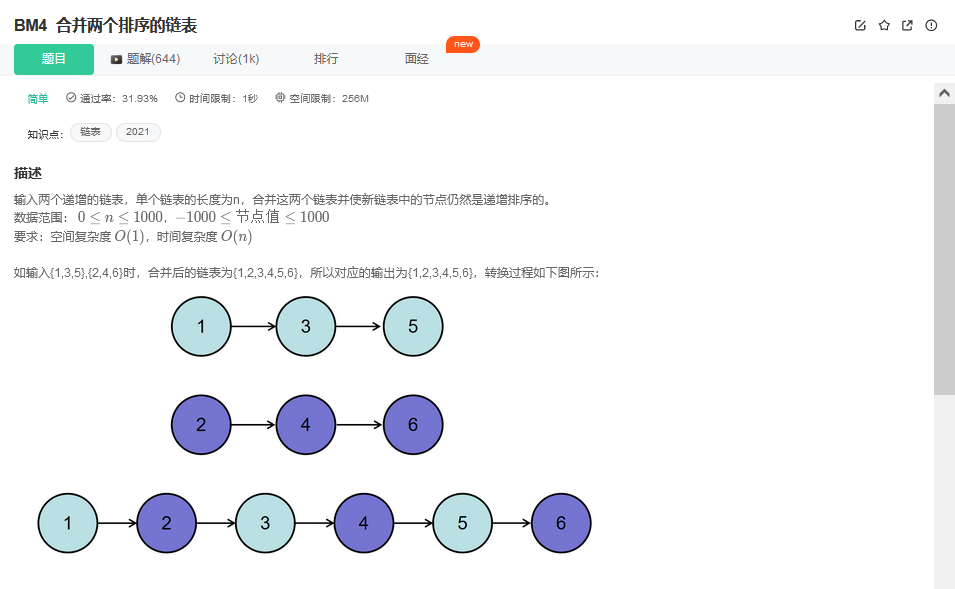
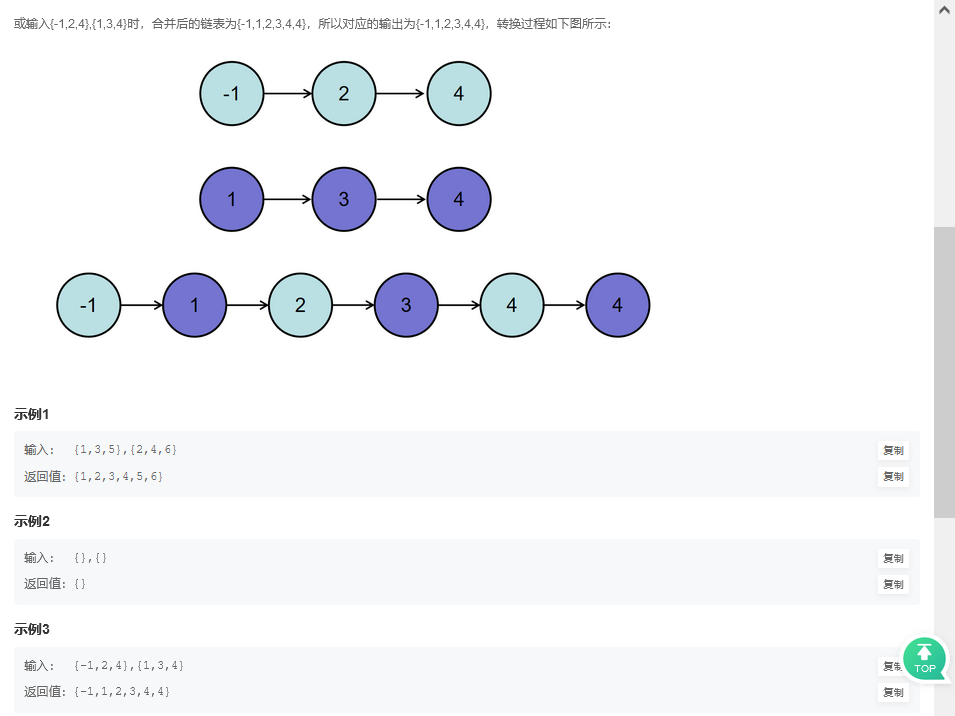
5.2. 解题思路
方法一:双指针迭代(推荐使用)
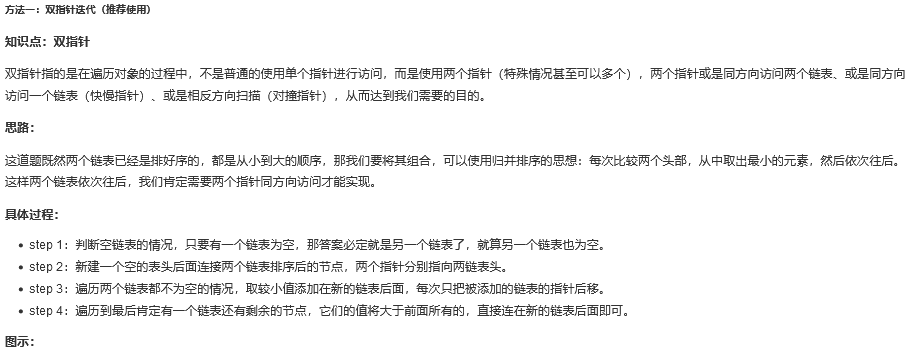

Java实现代码:
public class Solution {public ListNode Merge(ListNode list1,ListNode list2) {//一个已经为空了,直接返回另一个if(list1 == null) return list2;if(list2 == null)return list1;//加一个表头ListNode head = new ListNode(0); ListNode cur = head;//两个链表都要不为空while(list1 != null && list2 != null){ //取较小值的节点if(list1.val <= list2.val){ cur.next = list1;//只移动取值的指针list1 = list1.next; }else{cur.next = list2;//只移动取值的指针list2 = list2.next; }//指针后移cur = cur.next; }//哪个链表还有剩,直接连在后面if(list1 != null) cur.next = list1;elsecur.next = list2;//返回值去掉表头return head.next; }
}

方法二:双指针递归(扩展思路)

Java实现代码:
public class Solution {public ListNode Merge(ListNode list1,ListNode list2) {//一个已经为空了,返回另一个if(list1 == null) return list2;if(list2 == null)return list1;//先用较小的值的节点if(list1.val <= list2.val){ //递归往下list1.next = Merge(list1.next, list2); return list1; }else{//递归往下list2.next = Merge(list1, list2.next); return list2;}}
}
6. 合并k个已排序的链表(较难)
6.1. 题目描述



6.2. 解题思路
方法一:归并排序思想(推荐使用)
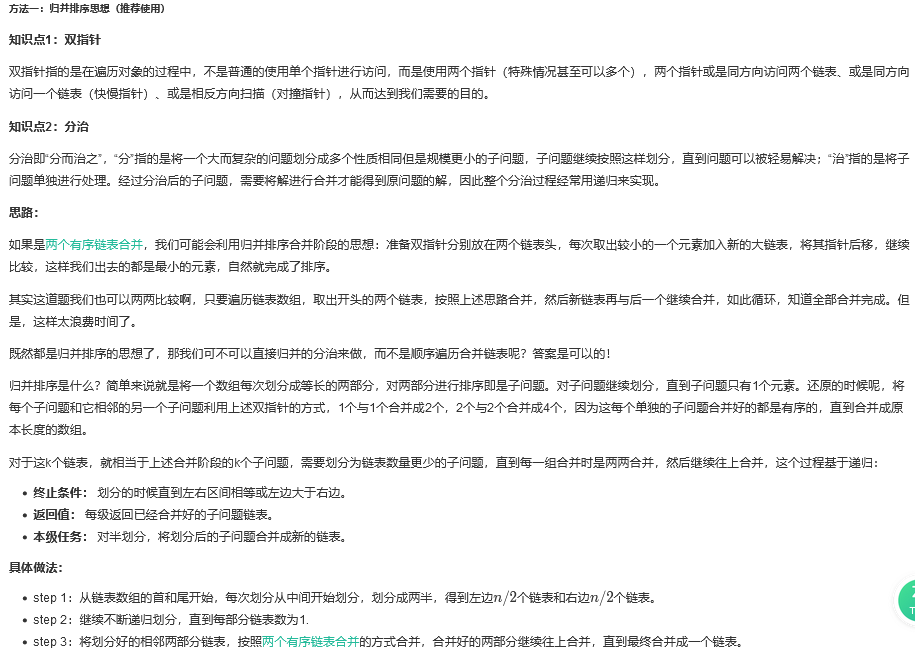
图示:
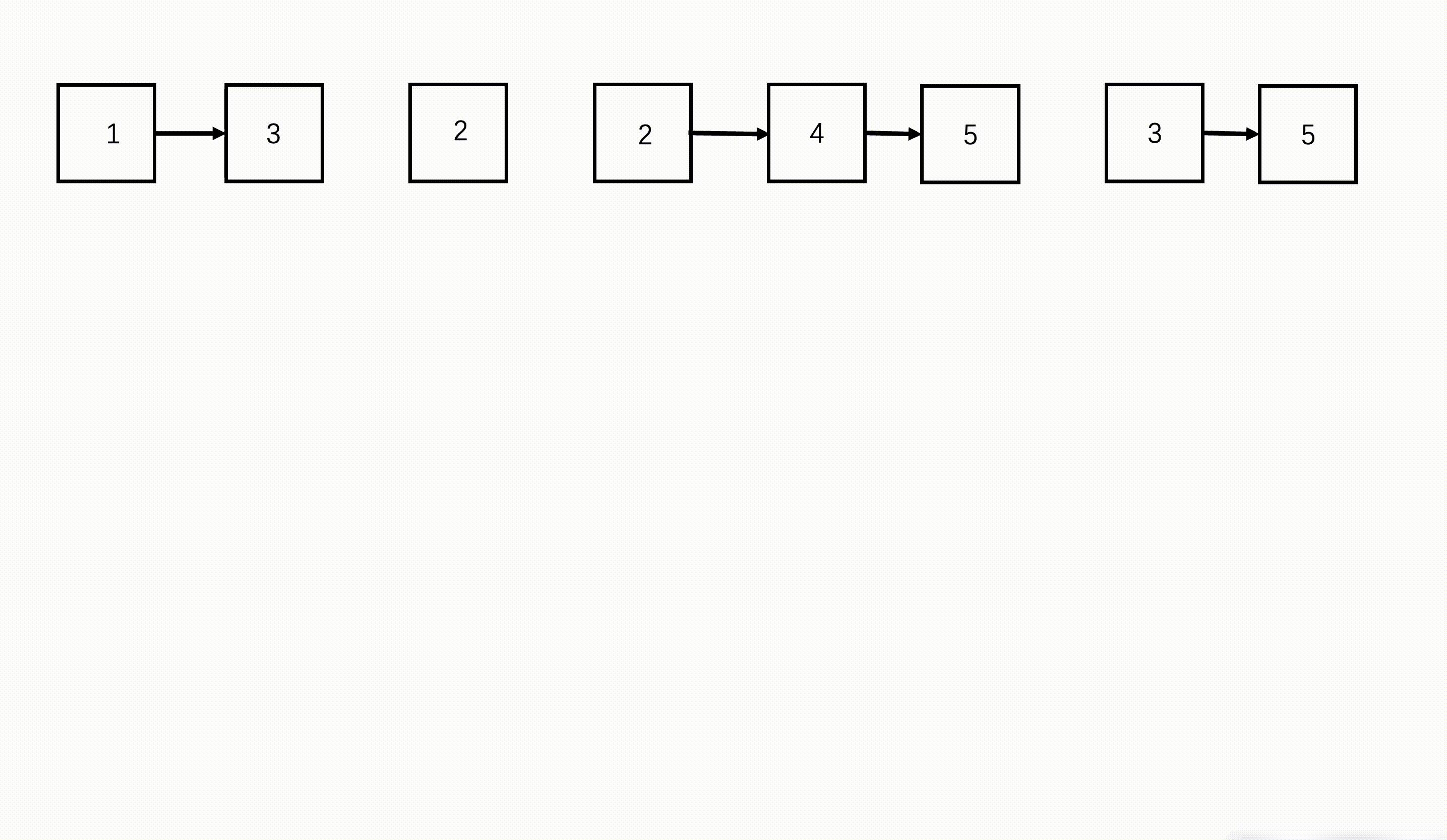
Java实现代码:
import java.util.ArrayList;
public class Solution {//两个链表合并函数public ListNode Merge(ListNode list1, ListNode list2) { //一个已经为空了,直接返回另一个if(list1 == null) return list2;if(list2 == null)return list1;//加一个表头ListNode head = new ListNode(0); ListNode cur = head;//两个链表都要不为空while(list1 != null && list2 != null){ //取较小值的节点if(list1.val <= list2.val){ cur.next = list1;//只移动取值的指针list1 = list1.next; }else{cur.next = list2;//只移动取值的指针list2 = list2.next; }//指针后移cur = cur.next; }//哪个链表还有剩,直接连在后面if(list1 != null) cur.next = list1;elsecur.next = list2;//返回值去掉表头return head.next; }//划分合并区间函数ListNode divideMerge(ArrayList<ListNode> lists, int left, int right){ if(left > right) return null;//中间一个的情况else if(left == right) return lists.get(left);//从中间分成两段,再将合并好的两段合并int mid = (left + right) / 2; return Merge(divideMerge(lists, left, mid), divideMerge(lists, mid + 1, right));}public ListNode mergeKLists(ArrayList<ListNode> lists) {//k个链表归并排序return divideMerge(lists, 0, lists.size() - 1);}
}
方法二:优先队列(扩展思路)

Java实现代码:
import java.util.*;
public class Solution {public ListNode mergeKLists(ArrayList<ListNode> lists) {//小顶堆Queue<ListNode> pq = new PriorityQueue<>((v1, v2) -> v1.val - v2.val); //遍历所有链表第一个元素for(int i = 0; i < lists.size(); i++){ //不为空则加入小顶堆if(lists.get(i) != null) pq.add(lists.get(i));}//加一个表头ListNode res = new ListNode(-1); ListNode head = res;//直到小顶堆为空while(!pq.isEmpty()){ //取出最小的元素ListNode temp = pq.poll(); //连接head.next = temp; head = head.next;//每次取出链表的后一个元素加入小顶堆if(temp.next != null) pq.add(temp.next);}//去掉表头return res.next; }
}
7. 判断链表中是否有环(简单)
7.1. 题目描述
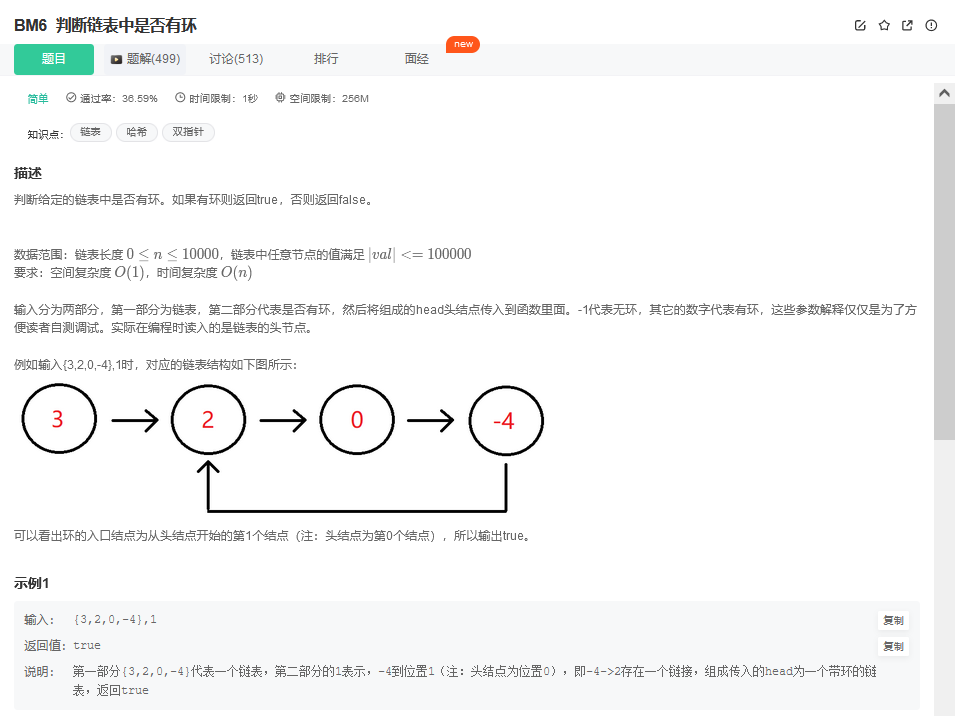

7.2. 解题思路
方法:双指针(推荐使用)
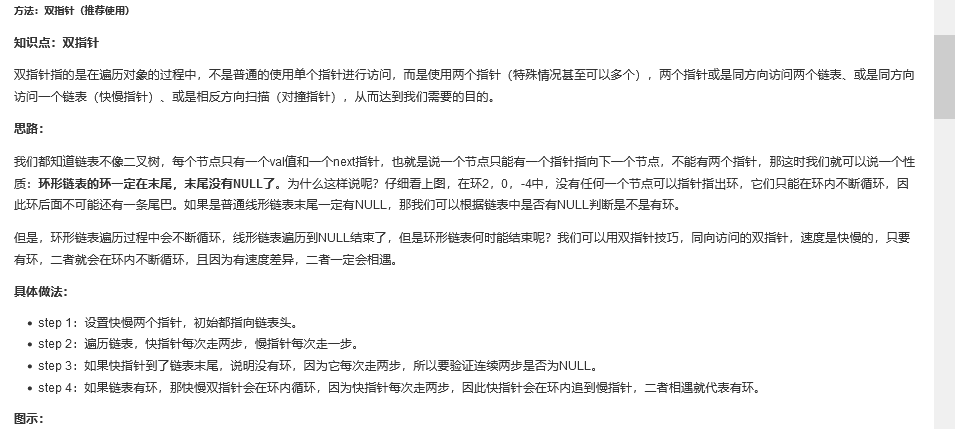
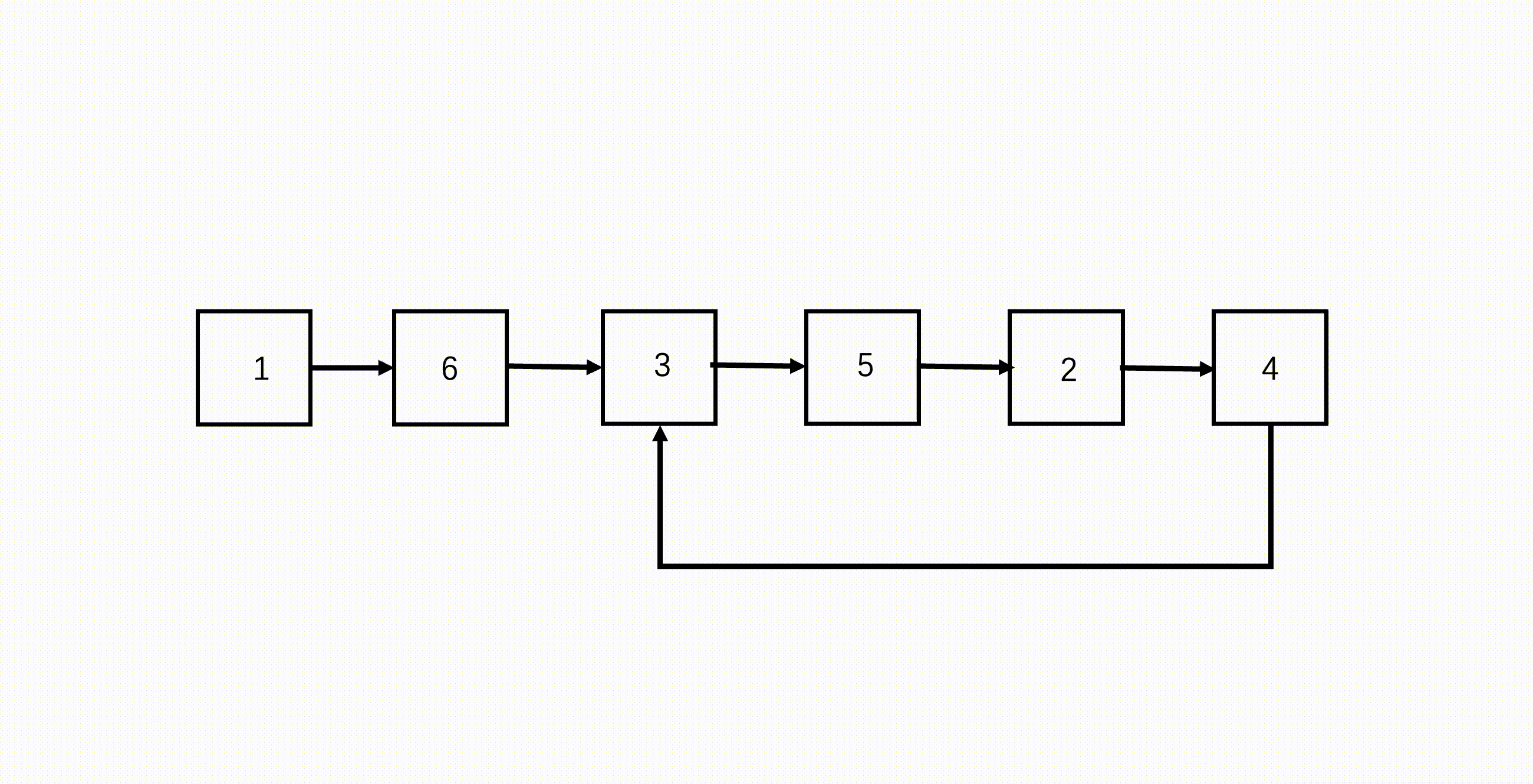
Java实现代码:
public class Solution {public boolean hasCycle(ListNode head) {//先判断链表为空的情况if(head == null) return false;//快慢双指针ListNode fast = head; ListNode slow = head;//如果没环快指针会先到链表尾while(fast != null && fast.next != null){ //快指针移动两步fast = fast.next.next; //慢指针移动一步slow = slow.next; //相遇则有环if(fast == slow) return true;}//到末尾则没有环return false; }
}
8. 链表中环的入口结点(中等)
8.1. 题目描述


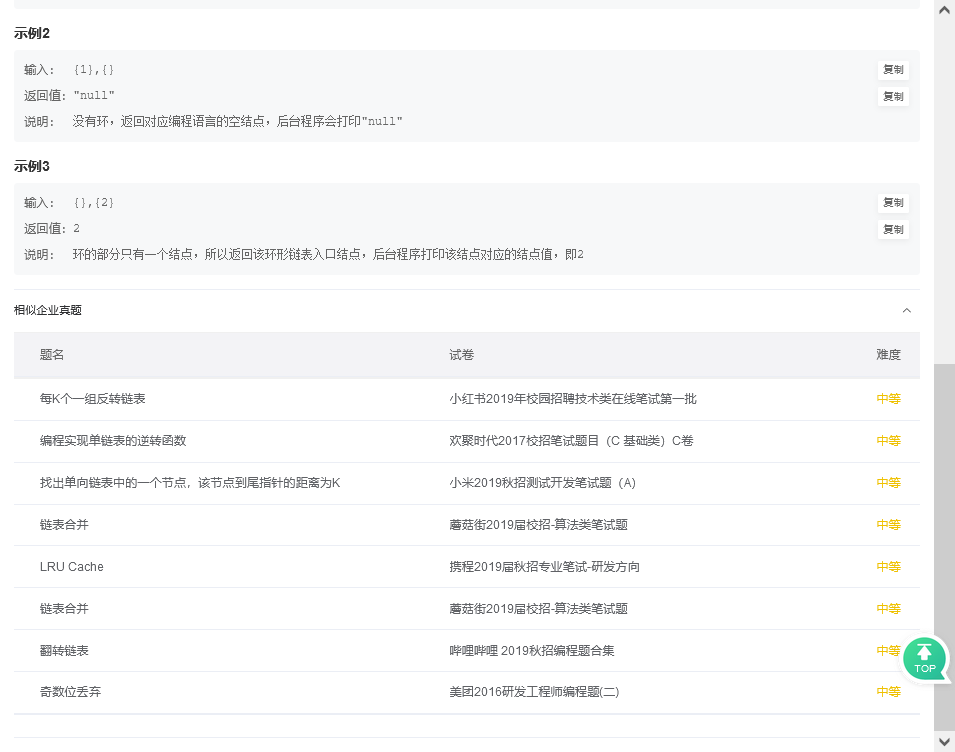

8.2. 解题思路
方法:双指针(推荐使用)

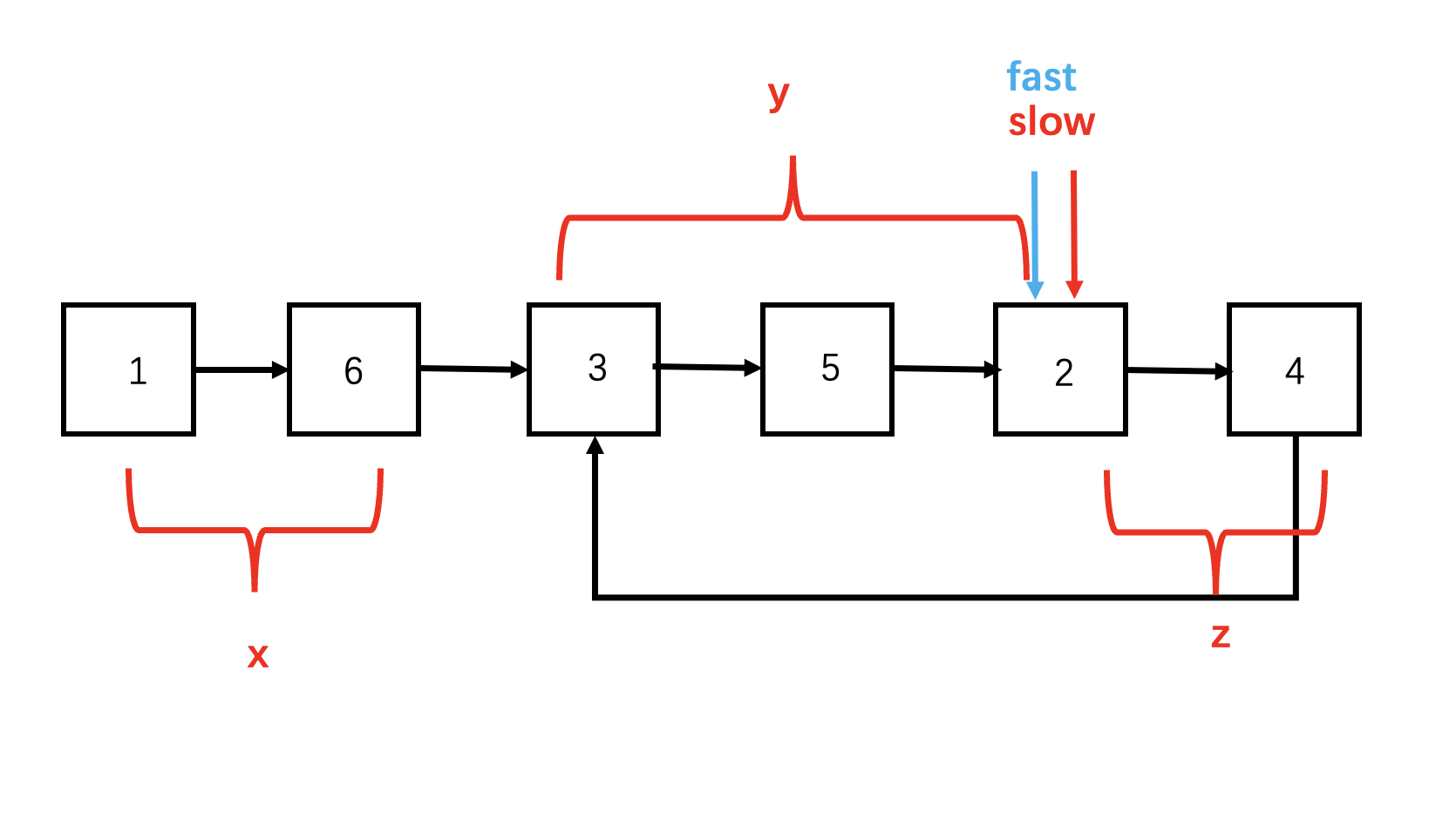

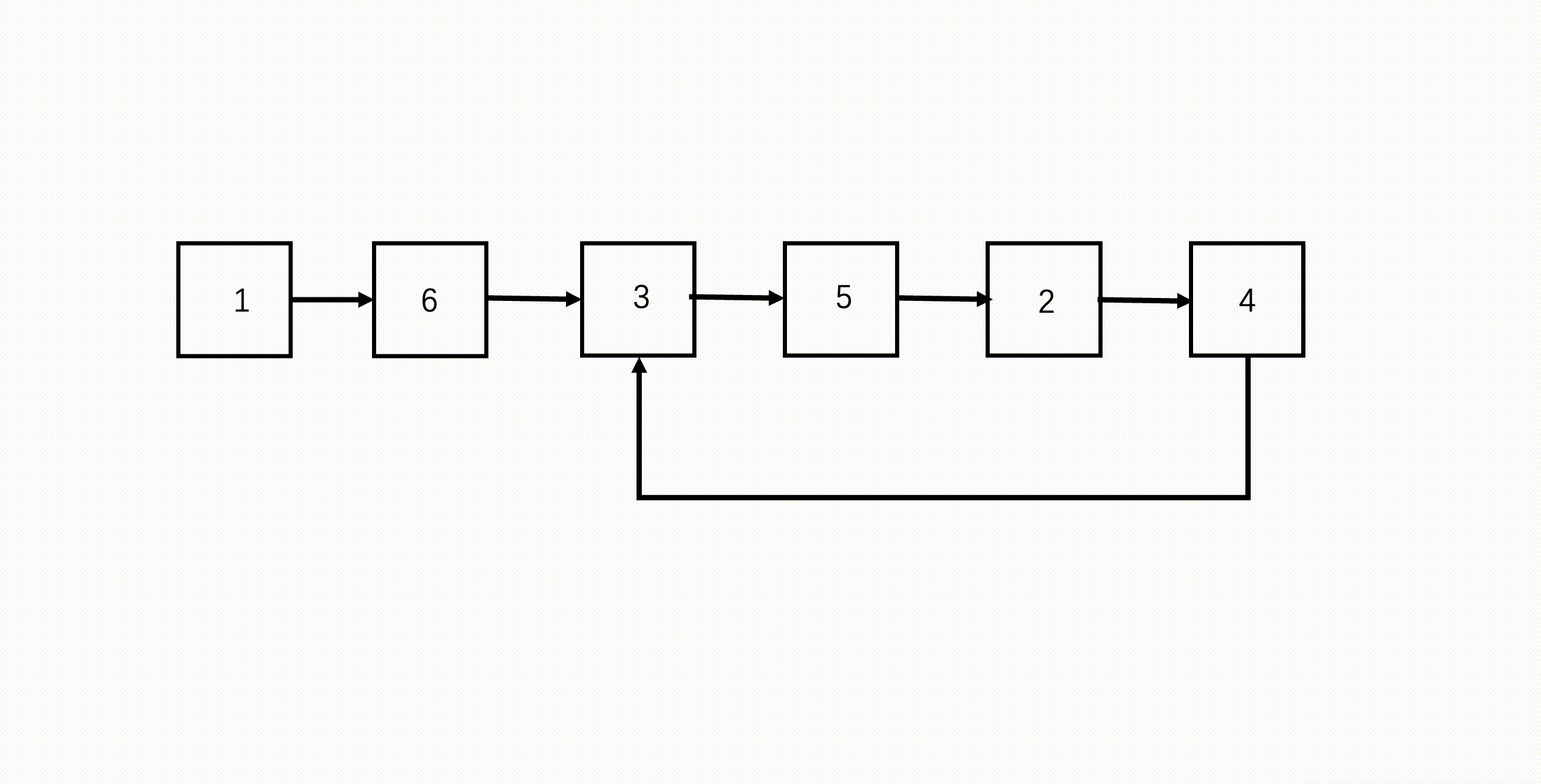
Java实现代码:
public class Solution {//判断有没有环,返回相遇的地方public ListNode hasCycle(ListNode head) {//先判断链表为空的情况if(head == null) return null;//快慢双指针ListNode fast = head; ListNode slow = head;//如果没环快指针会先到链表尾while(fast != null && fast.next != null){ //快指针移动两步fast = fast.next.next; //慢指针移动一步slow = slow.next; //相遇则有环,返回相遇的位置if(fast == slow) return slow;}//到末尾说明没有环,返回nullreturn null; }public ListNode EntryNodeOfLoop(ListNode pHead) {ListNode slow = hasCycle(pHead);//没有环if(slow == null) return null;//快指针回到表头ListNode fast = pHead; //再次相遇即是环入口while(fast != slow){ fast = fast.next;slow = slow.next;}return slow;}
}

9. 相交链表(简单)
9.1. 题目描述
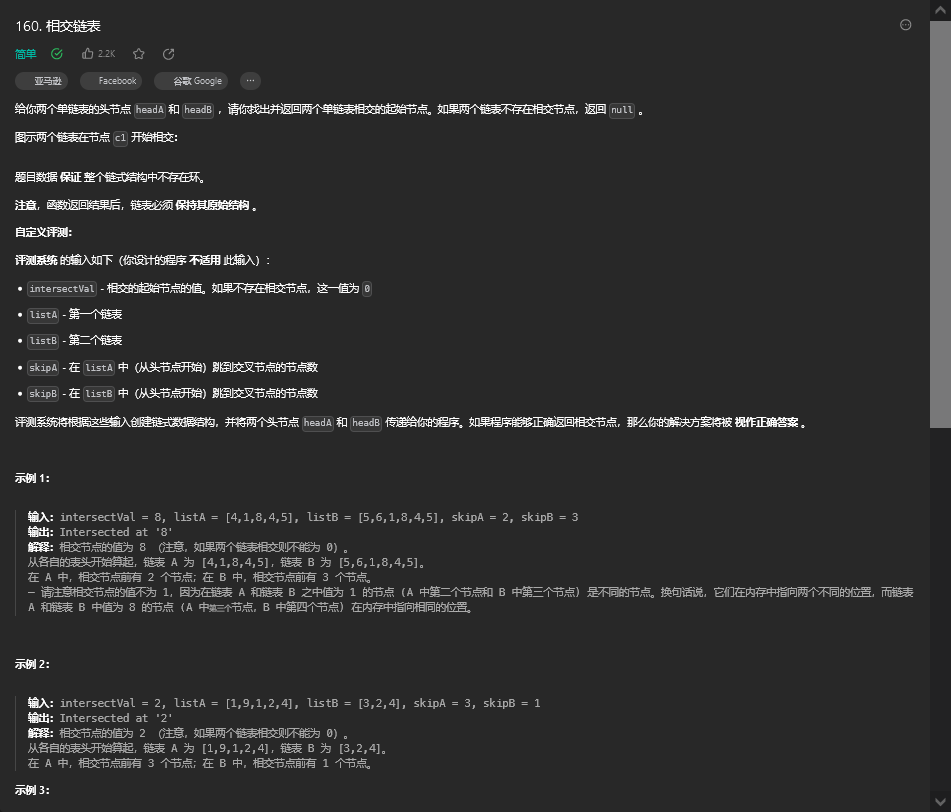

9.2. 解题思路
方法一:哈希集合


public class Solution {public ListNode getIntersectionNode(ListNode headA, ListNode headB) {Set<ListNode> visited = new HashSet<ListNode>();ListNode temp = headA;while (temp != null) {visited.add(temp);temp = temp.next;}temp = headB;while (temp != null) {if (visited.contains(temp)) {return temp;}temp = temp.next;}return null;}
}

方法二:双指针

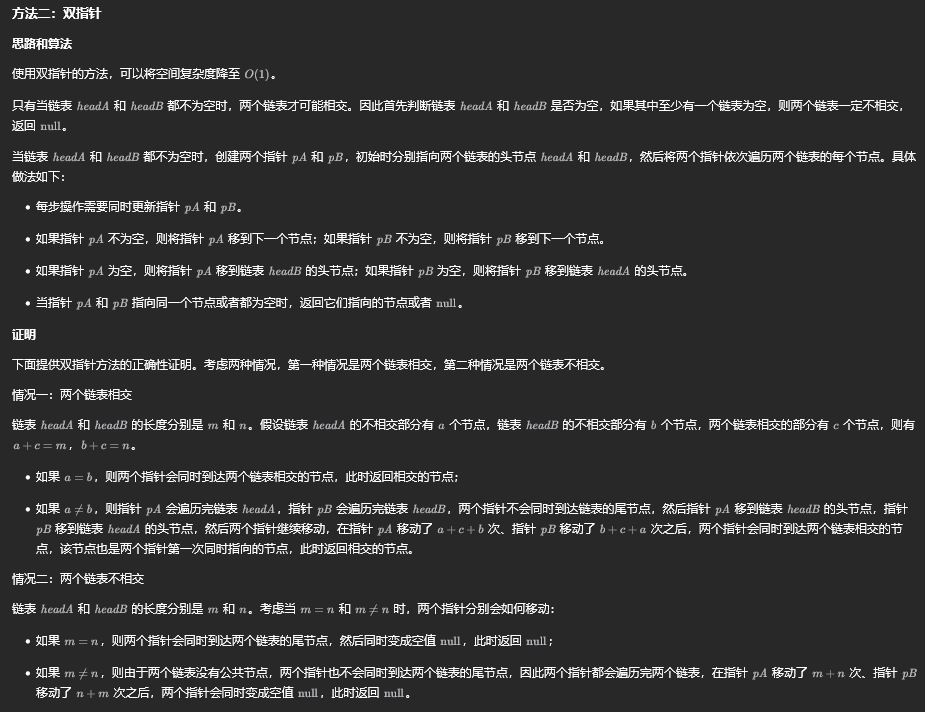
public class Solution {public ListNode getIntersectionNode(ListNode headA, ListNode headB) {if (headA == null || headB == null) {return null;}ListNode pA = headA, pB = headB;while (pA != pB) {pA = pA == null ? headB : pA.next;pB = pB == null ? headA : pB.next;}return pA;}
}

10. 环形链表II(中等)
10.1. 题目描述
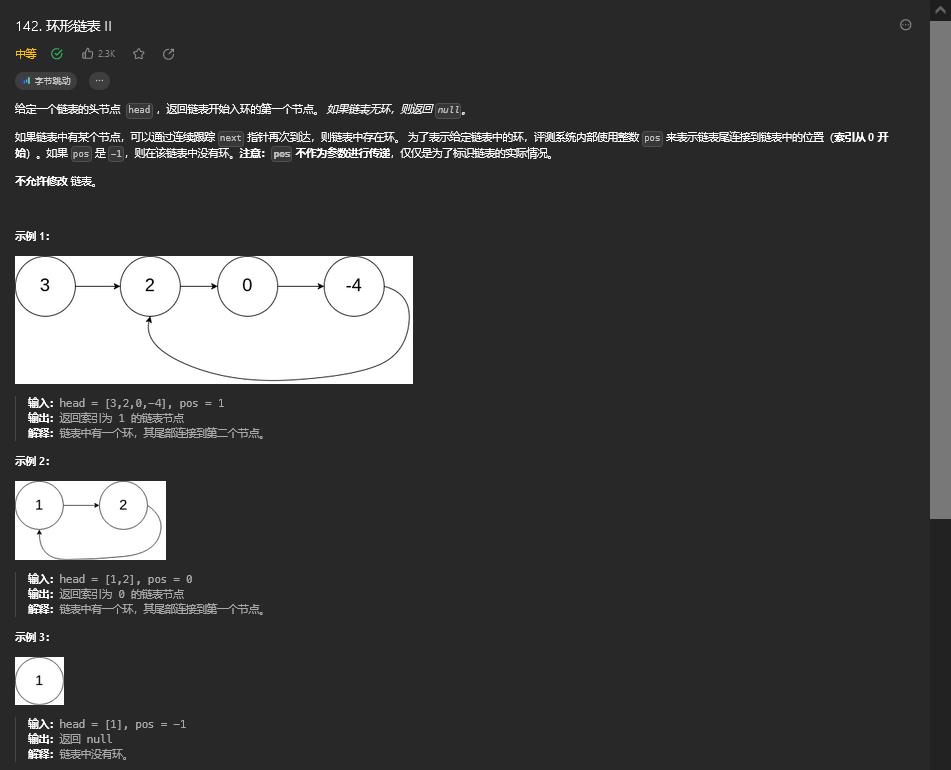
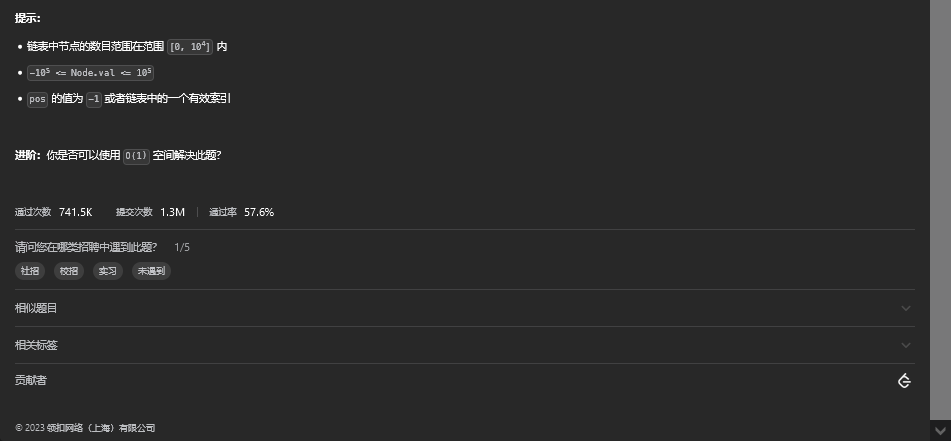
10.2. 解题思路
方法一:哈希表


public class Solution {public ListNode detectCycle(ListNode head) {ListNode pos = head;Set<ListNode> visited = new HashSet<ListNode>();while (pos != null) {if (visited.contains(pos)) {return pos;} else {visited.add(pos);}pos = pos.next;}return null;}
}

方法二:快慢指针

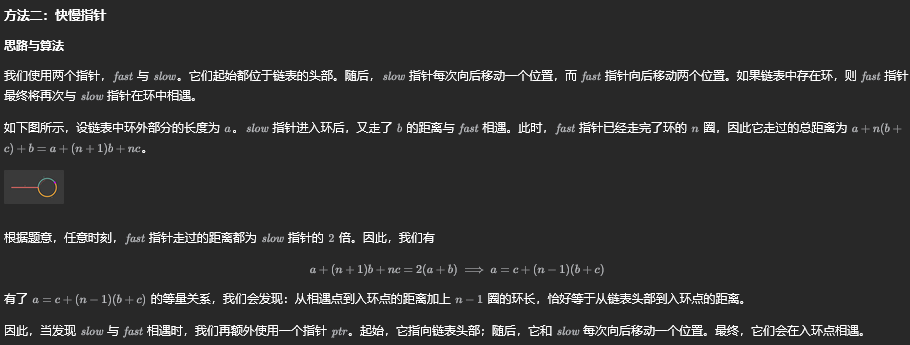
public class Solution {public ListNode detectCycle(ListNode head) {if (head == null) {return null;}ListNode slow = head, fast = head;while (fast != null) {slow = slow.next;if (fast.next != null) {fast = fast.next.next;} else {return null;}if (fast == slow) {ListNode ptr = head;while (ptr != slow) {ptr = ptr.next;slow = slow.next;}return ptr;}}return null;}
}

11. 链表中倒数最后k个结点(简单)
11.1. 题目描述
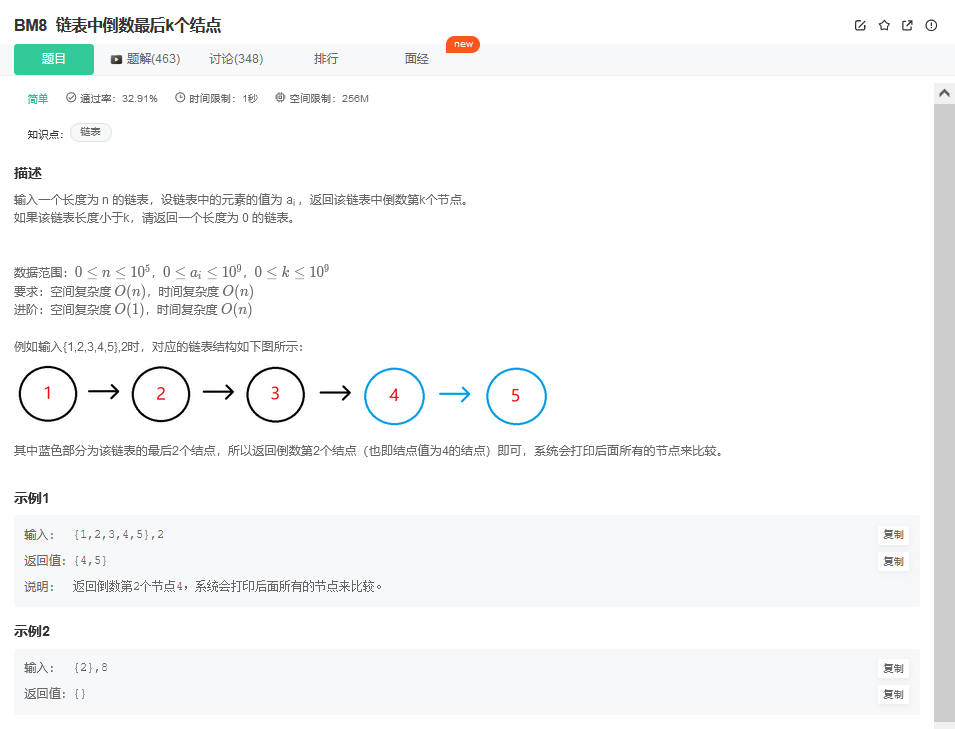
11.2. 解题思路
方法一:快慢双指针(推荐使用)
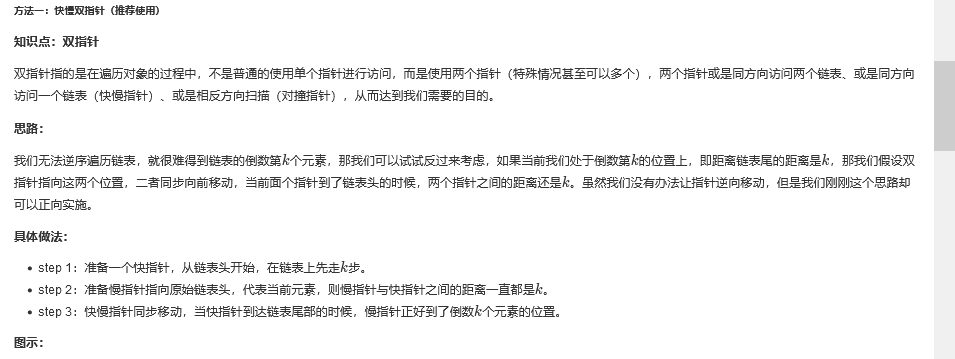
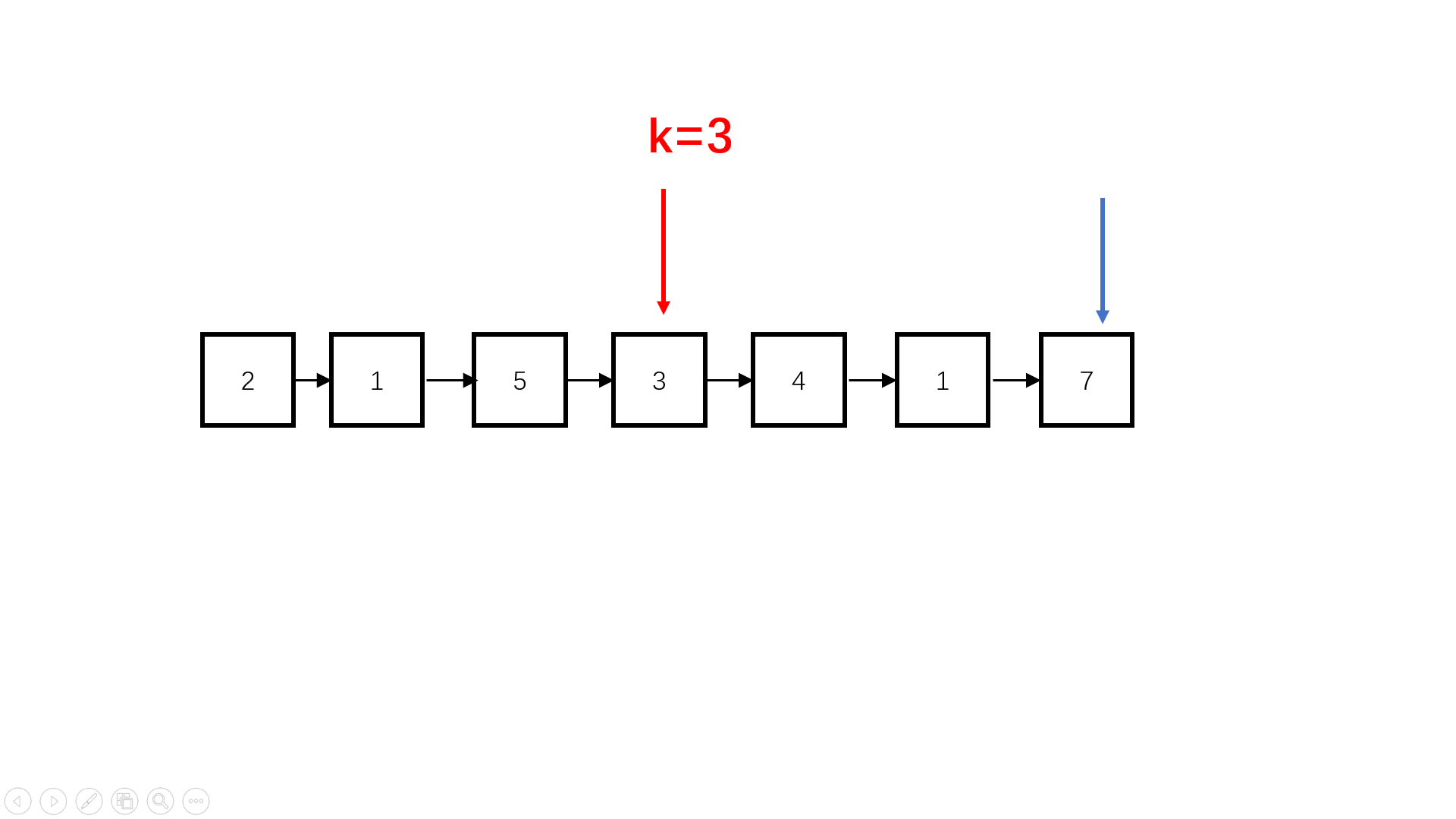
Java实现代码:
import java.util.*;
public class Solution {public ListNode FindKthToTail (ListNode pHead, int k) {int n = 0;ListNode fast = pHead; ListNode slow = pHead;//快指针先行k步for(int i = 0; i < k; i++){ if(fast != null)fast = fast.next;//达不到k步说明链表过短,没有倒数kelse return slow = null;}//快慢指针同步,快指针先到底,慢指针指向倒数第k个while(fast != null){ fast = fast.next;slow = slow.next;}return slow;}
}

方法二:先找长度再找最后k(扩展思路)

Java实现代码:
import java.util.*;
public class Solution {public ListNode FindKthToTail (ListNode pHead, int k) {int n = 0;ListNode p = pHead;//遍历链表,统计链表长度while(p != null){n++;p = p.next;}//长度过小,返回空链表if(n < k) return null;p = pHead;//遍历n-k次for(int i = 0; i < n - k; i++) p = p.next;return p;}
}

12. 两个链表的第一个公共结点(简单)
12.1. 题目描述
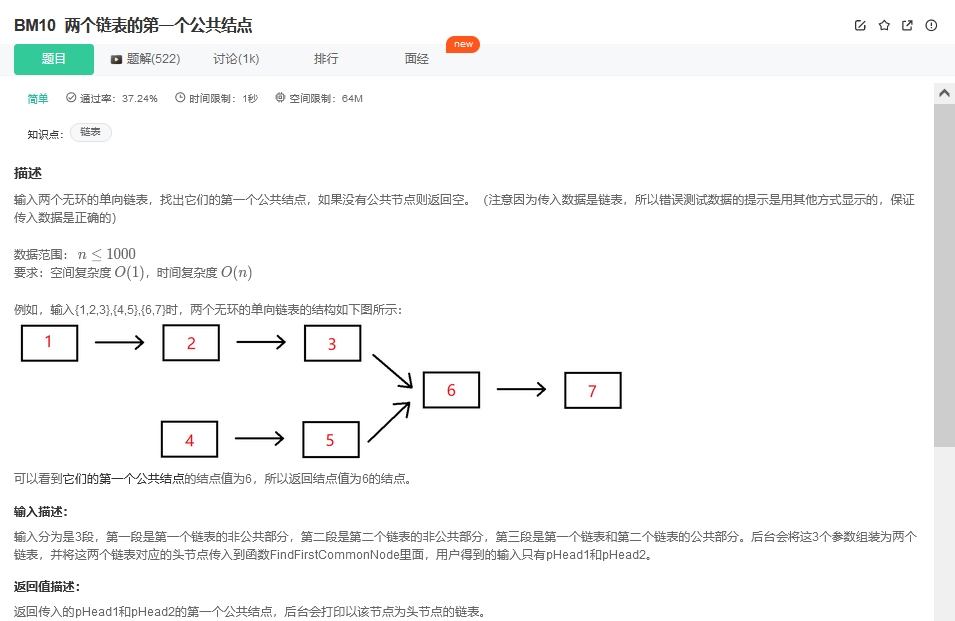

12.2. 解题思路
方法:双指针

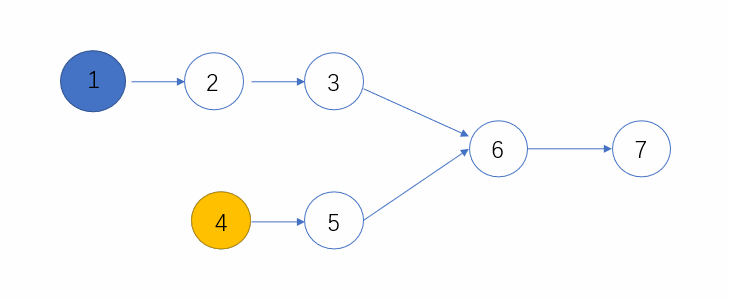
Java实现代码:
public class Solution {public ListNode FindFirstCommonNode(ListNode pHead1, ListNode pHead2) {ListNode l1 = pHead1, l2 = pHead2;while(l1 != l2){l1 = (l1==null)?pHead2:l1.next;l2 = (l2==null)?pHead1:l2.next;}return l1;}
}
13. 链表相加(二)(中等)
13.1. 题目描述
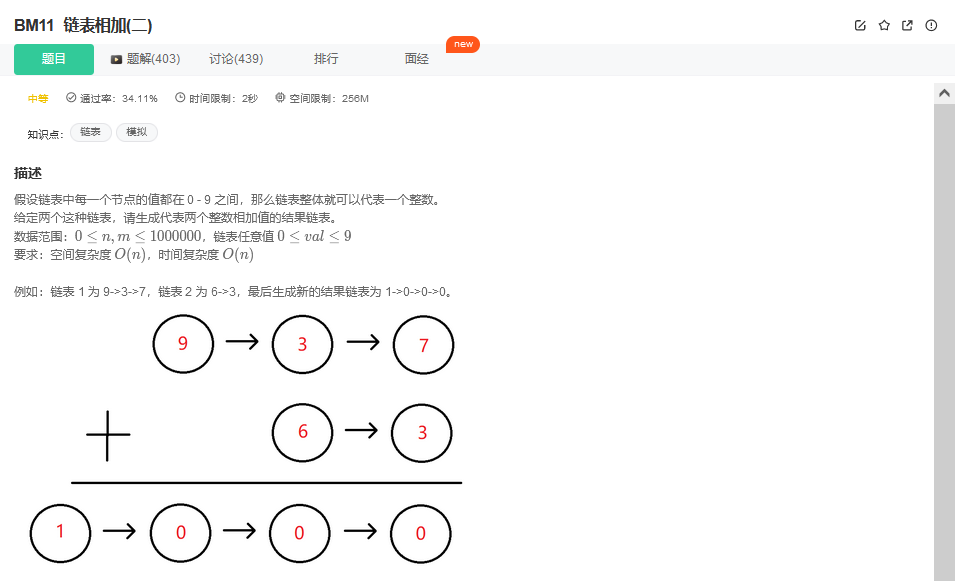

13.2 解题思路
方法:反转链表法(推荐使用)
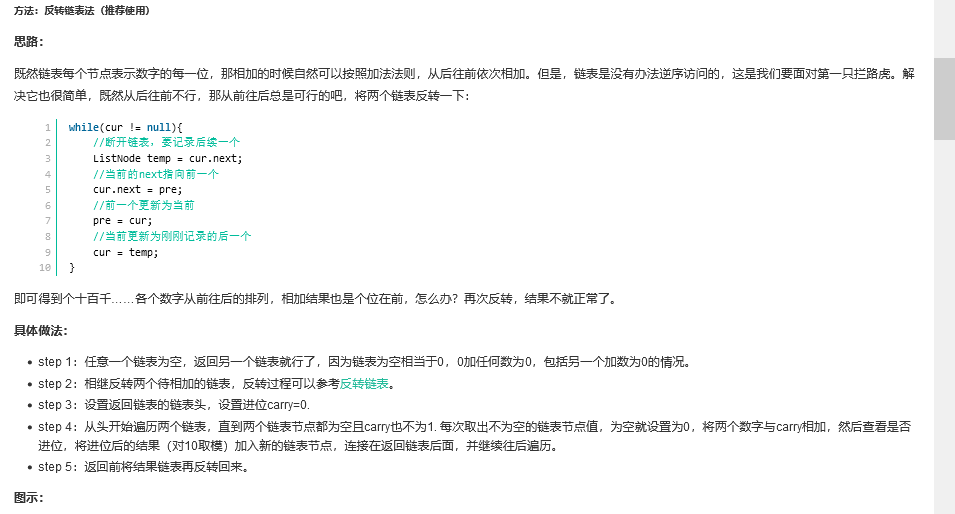

Java实现代码:
import java.util.*;
public class Solution {//反转链表public ListNode ReverseList(ListNode pHead) { if(pHead == null)return null;ListNode cur = pHead;ListNode pre = null;while(cur != null){//断开链表,要记录后续一个ListNode temp = cur.next;//当前的next指向前一个cur.next = pre; //前一个更新为当前pre = cur; //当前更新为刚刚记录的后一个cur = temp; }return pre;}public ListNode addInList (ListNode head1, ListNode head2) {//任意一个链表为空,返回另一个if(head1 == null) return head2;if(head2 == null)return head1;//反转两个链表head1 = ReverseList(head1); head2 = ReverseList(head2);//添加表头ListNode res = new ListNode(-1); ListNode head = res;//进位符号int carry = 0; //只要某个链表还有或者进位还有while(head1 != null || head2 != null || carry != 0){ //链表不为空则取其值int val1 = head1 == null ? 0 : head1.val; int val2 = head2 == null ? 0 : head2.val;//相加int temp = val1 + val2 + carry; //获取进位carry = temp / 10; temp %= 10; //添加元素head.next = new ListNode(temp); head = head.next;//移动下一个if(head1 != null) head1 = head1.next;if(head2 != null)head2 = head2.next;}//结果反转回来return ReverseList(res.next); }
}

14. 两数相加(中等)
14.1. 题目描述
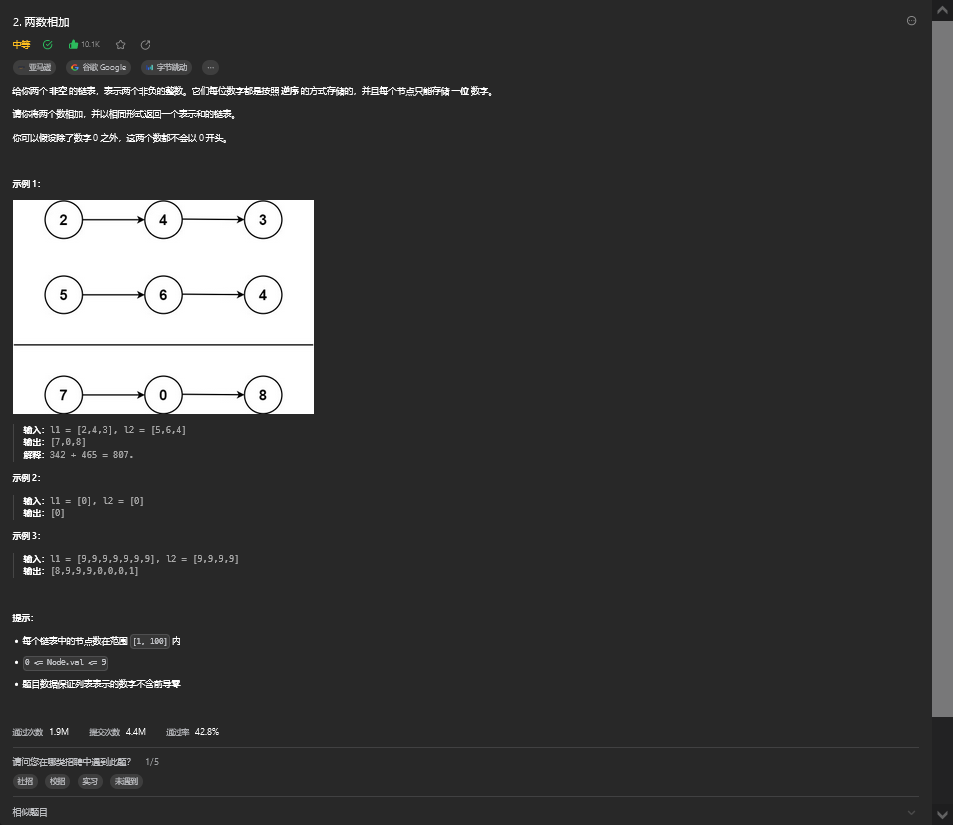
14.2. 解题思路
方法一:模拟法

class Solution {public ListNode addTwoNumbers(ListNode l1, ListNode l2) {ListNode head = null, tail = null;int carry = 0;while (l1 != null || l2 != null) {int n1 = l1 != null ? l1.val : 0;int n2 = l2 != null ? l2.val : 0;int sum = n1 + n2 + carry;if (head == null) {head = tail = new ListNode(sum % 10);} else {tail.next = new ListNode(sum % 10);tail = tail.next;}carry = sum / 10;if (l1 != null) {l1 = l1.next;}if (l2 != null) {l2 = l2.next;}}if (carry > 0) {tail.next = new ListNode(carry);}return head;}
}

15. 单链表的排序(中等)
15.1. 题目描述
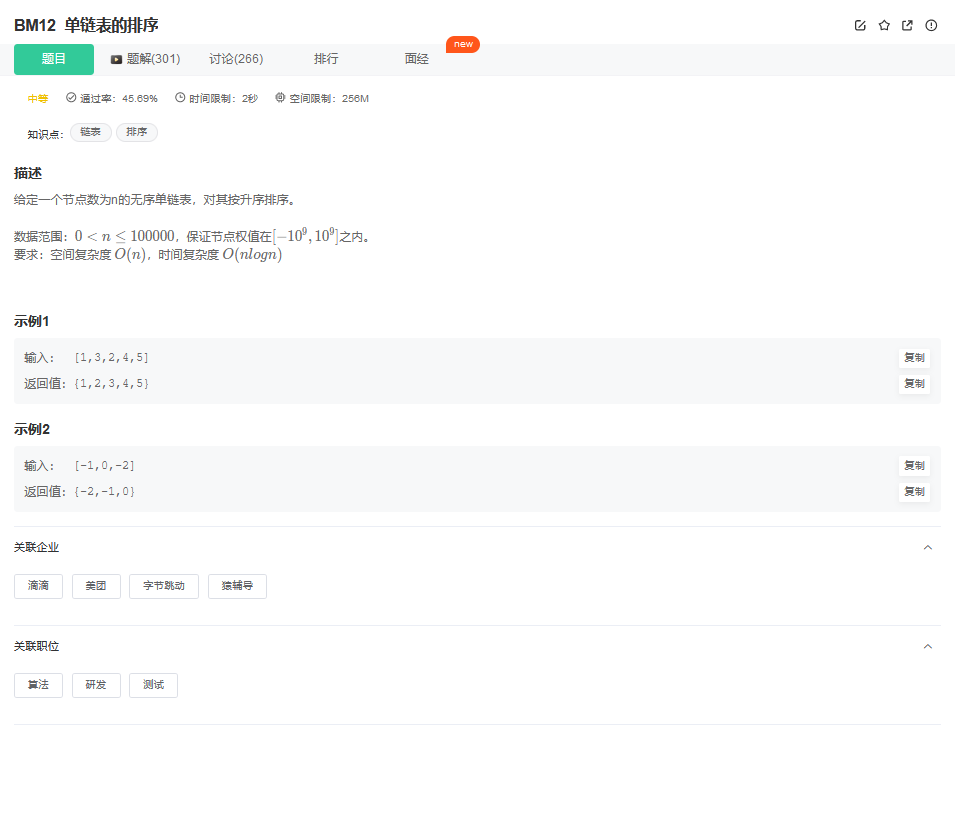
15.2. 解题思路
方法一:归并排序(推荐使用)

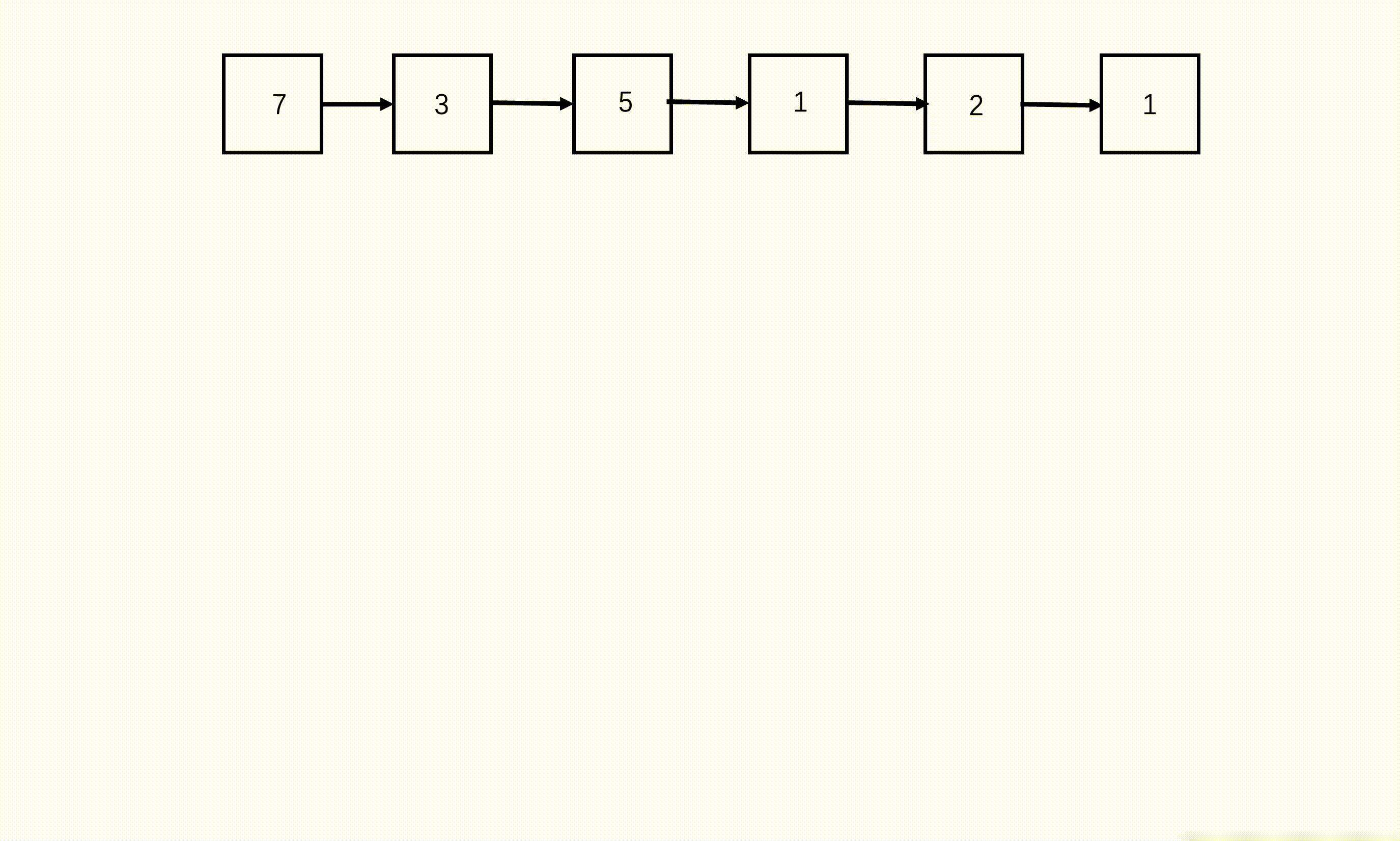
Java实现代码:
import java.util.*;
public class Solution {//合并两段有序链表ListNode merge(ListNode pHead1, ListNode pHead2) { //一个已经为空了,直接返回另一个if(pHead1 == null) return pHead2;if(pHead2 == null)return pHead1;//加一个表头ListNode head = new ListNode(0); ListNode cur = head;//两个链表都要不为空while(pHead1 != null && pHead2 != null){ //取较小值的节点if(pHead1.val <= pHead2.val){ cur.next = pHead1;//只移动取值的指针pHead1 = pHead1.next; }else{cur.next = pHead2;//只移动取值的指针pHead2 = pHead2.next; }//指针后移cur = cur.next; }//哪个链表还有剩,直接连在后面if(pHead1 != null) cur.next = pHead1;elsecur.next = pHead2;//返回值去掉表头return head.next; }public ListNode sortInList (ListNode head) {//链表为空或者只有一个元素,直接就是有序的if(head == null || head.next == null) return head;ListNode left = head; ListNode mid = head.next;ListNode right = head.next.next;//右边的指针到达末尾时,中间的指针指向该段链表的中间while(right != null && right.next != null){ left = left.next;mid = mid.next;right = right.next.next;}//左边指针指向左段的左右一个节点,从这里断开left.next = null; //分成两段排序,合并排好序的两段return merge(sortInList(head), sortInList(mid)); }
}

方法二:转化为数组排序(扩展思路)

import java.util.*;
public class Solution {public ListNode sortInList (ListNode head) {ArrayList<Integer> nums = new ArrayList(); ListNode p = head;//遍历链表,将节点值加入数组while(p != null){ nums.add(p.val);p = p.next;}p = head;//对数组元素排序Collections.sort(nums); //遍历数组for(int i = 0; i < nums.size(); i++){ //将数组元素依次加入链表p.val = nums.get(i); p = p.next;}return head;}
}

16. 判断一个链表是否为回文结构(简单)
16.1. 题目描述

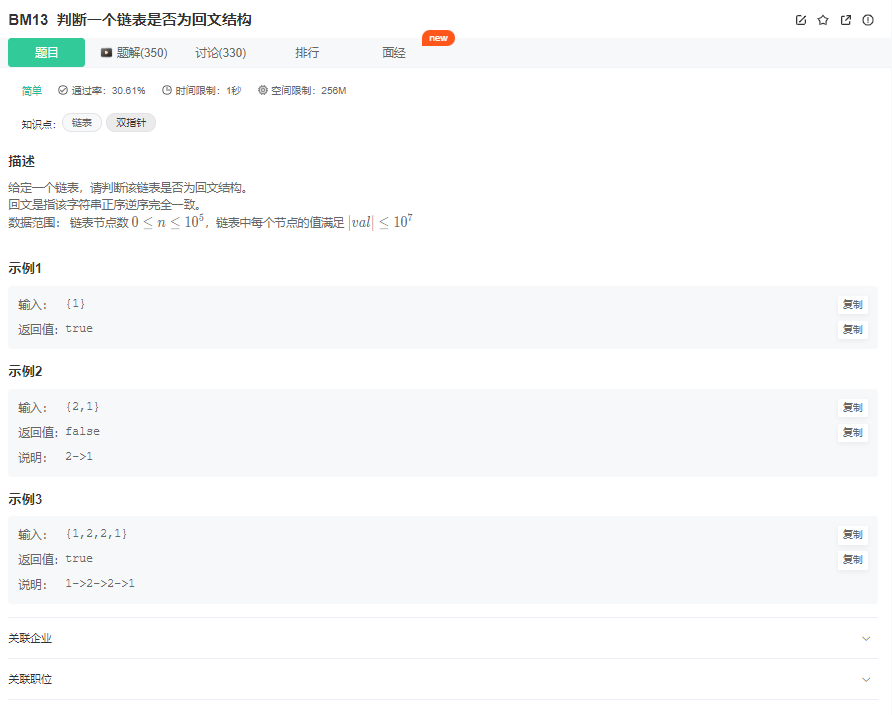
16.2. 解题思路
方法一:数组复制反转法(前置知识)

Java实现代码:
import java.util.*;
public class Solution {public boolean isPail (ListNode head) {ArrayList<Integer> nums = new ArrayList();//将链表元素取出一次放入数组while(head != null){ nums.add(head.val);head = head.next;}ArrayList<Integer> temp = new ArrayList();temp = (ArrayList<Integer>) nums.clone();//准备一个数组承接翻转之后的数组Collections.reverse(temp); for(int i = 0; i < nums.size(); i++){int x = nums.get(i);int y = temp.get(i);//正向遍历与反向遍历相同if(x != y) return false;}return true;}
}
方法二:数组复制双指针(前置知识)

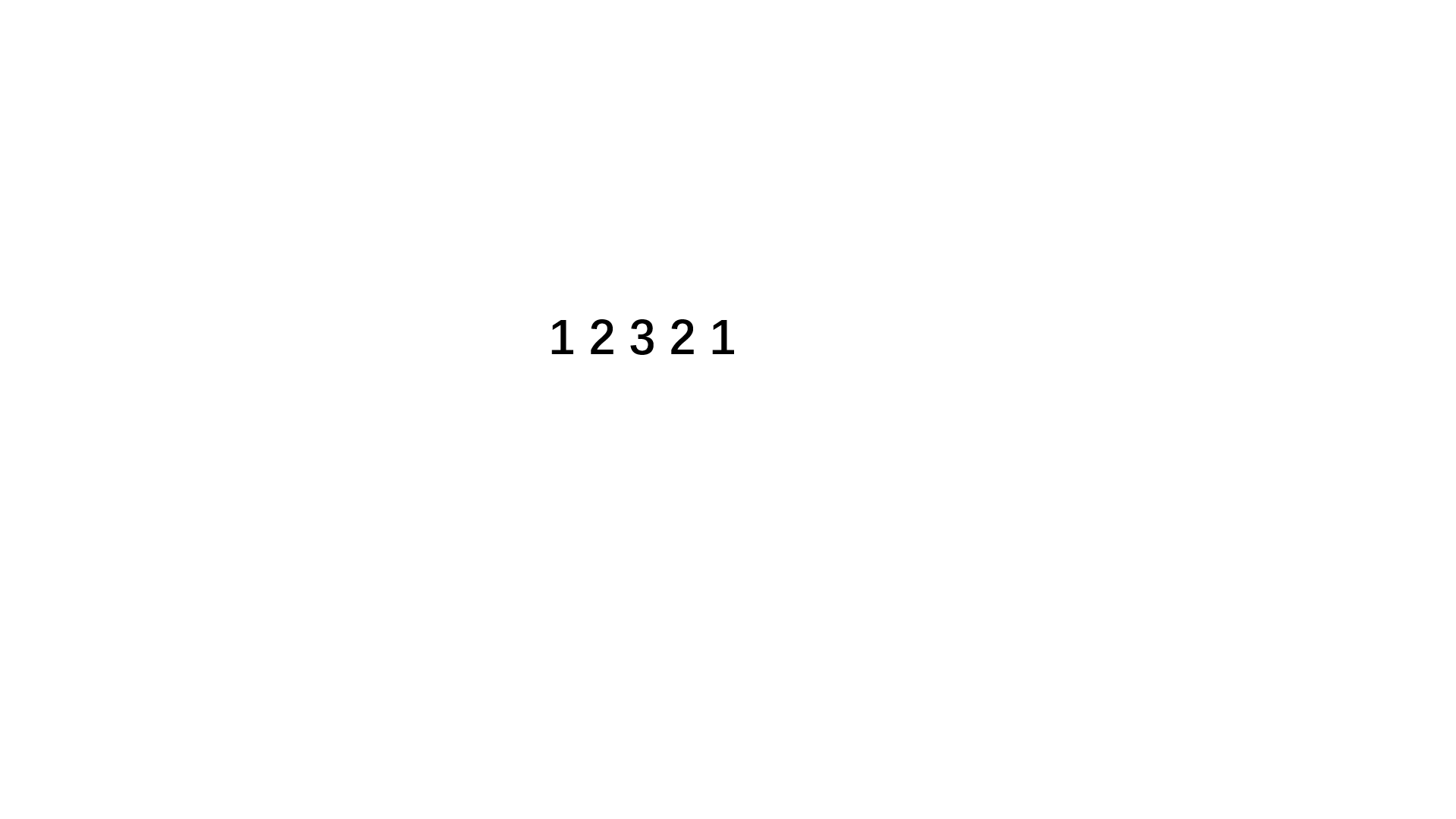
Java实现代码:
import java.util.*;
public class Solution {public boolean isPail (ListNode head) {ArrayList<Integer> nums = new ArrayList();//将链表元素取出一次放入数组while(head != null){ nums.add(head.val);head = head.next;}//双指针指向首尾int left = 0; int right = nums.size() - 1;//分别从首尾遍历,代表正序和逆序while(left <= right){ int x = nums.get(left);int y = nums.get(right);//如果不一致就是不为回文if(x != y) return false;left++;right--;}return true;}
}

方法三:长度法找中点(推荐使用)
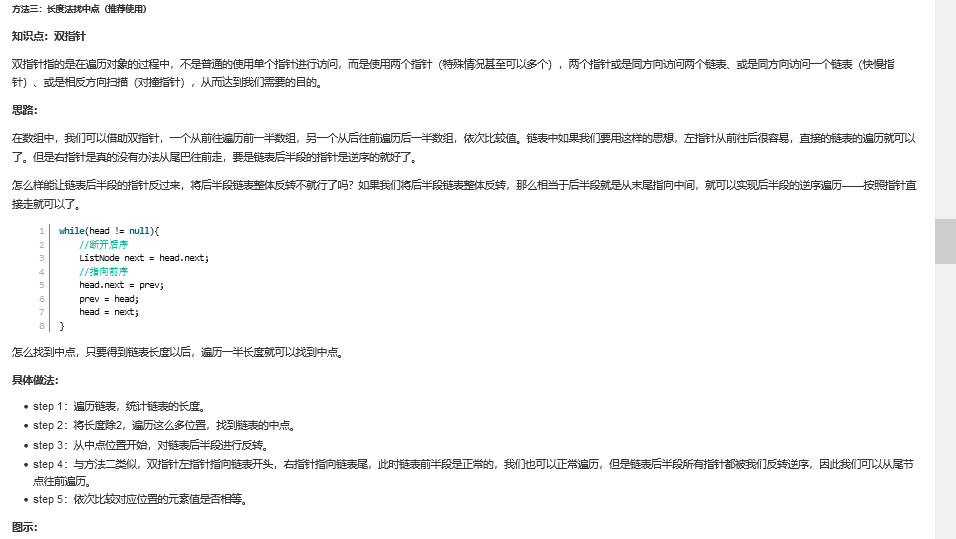
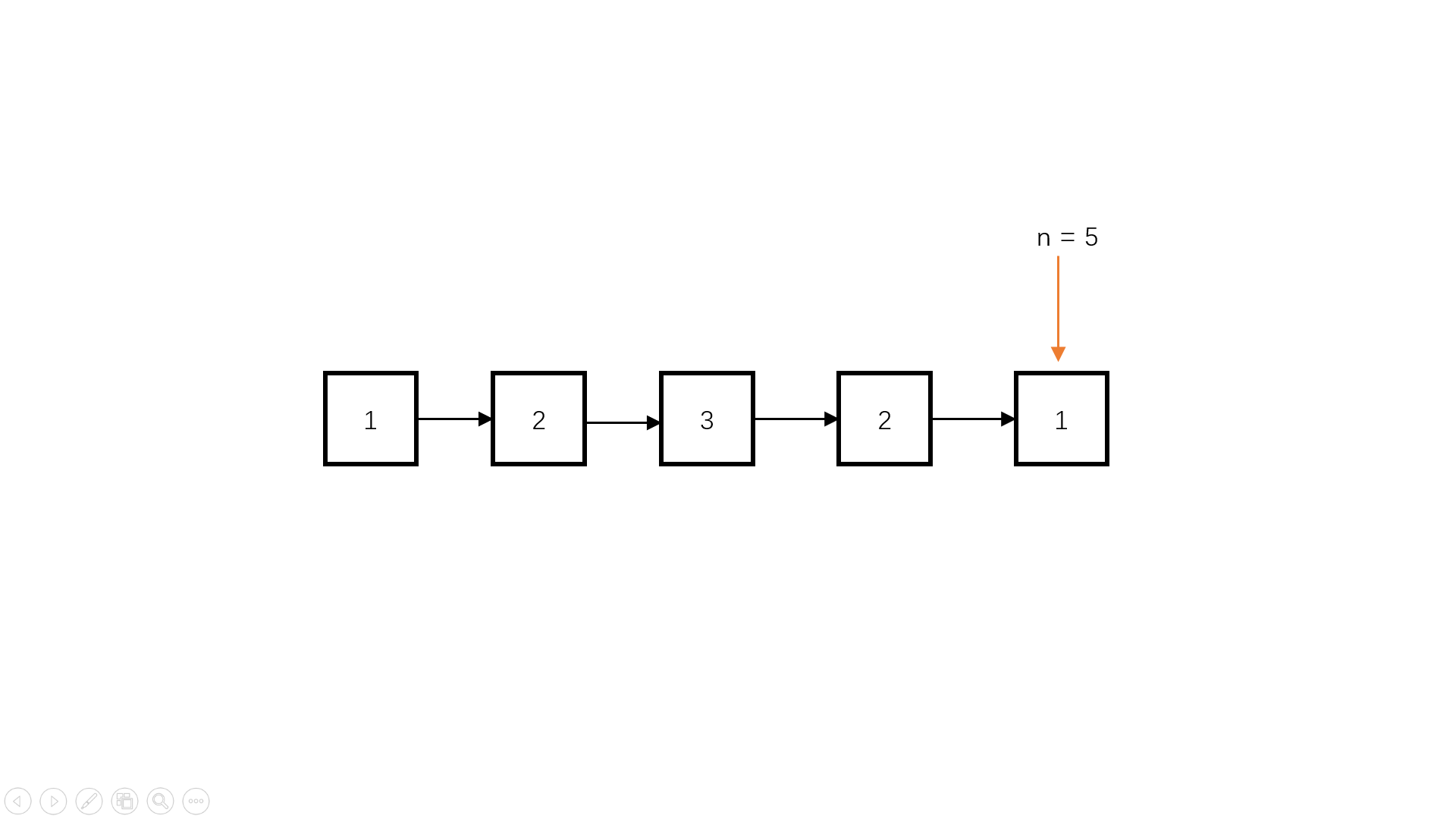
Java实现代码:
import java.util.*;
public class Solution {//反转链表指针ListNode reverse(ListNode head) { //前序节点ListNode prev = null; while(head != null){//断开后序ListNode next = head.next; //指向前序head.next = prev; prev = head;head = next;}return prev;}public boolean isPail (ListNode head) {ListNode p = head;int n = 0;//找到链表长度while(p != null){ n++;p = p.next; }//中点n = n / 2; p = head;//遍历到中点位置while(n > 0){ p = p.next;n--;}//中点处反转p = reverse(p); ListNode q = head;while(p != null){//比较判断节点值是否相等if(p.val != q.val) return false;p = p.next;q = q.next;}return true;}
}
方法四:双指针找中点(推荐使用)

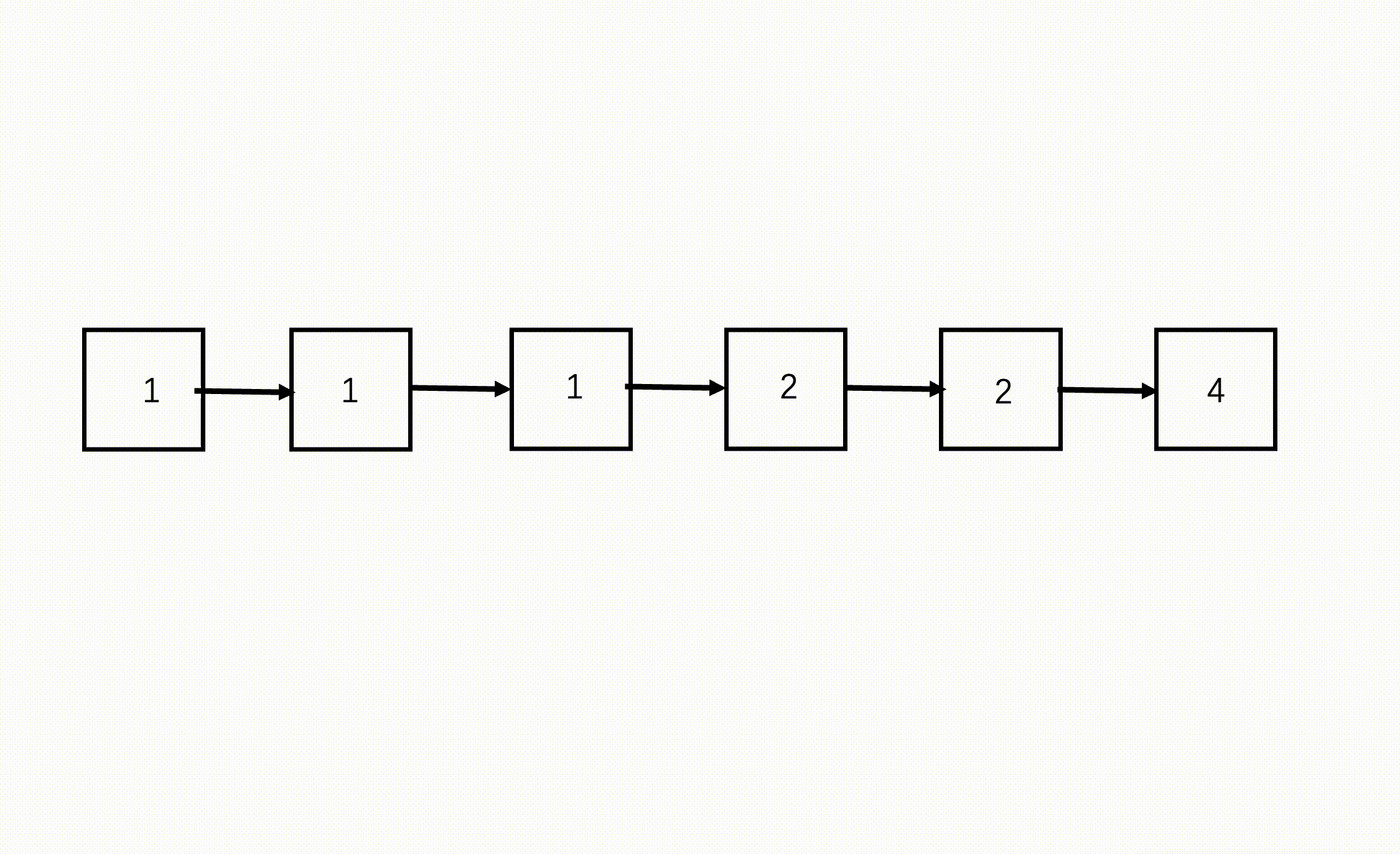
Java实现代码:
import java.util.*;
public class Solution {//反转链表指针ListNode reverse(ListNode head) { //前序节点ListNode prev = null; while(head != null){//断开后序ListNode next = head.next; //指向前序head.next = prev; prev = head;head = next;}return prev;}public boolean isPail (ListNode head) {//空链表直接为回文if(head == null) return true;//准备快慢双指针ListNode slow = head; ListNode fast = head;//双指针找中点while(fast != null && fast.next != null){ slow = slow.next;fast = fast.next.next;}//中点处反转slow = reverse(slow); fast = head;while(slow != null){ //比较判断节点值是否相等if(slow.val != fast.val) return false;fast = fast.next;slow = slow.next;}return true;}
}

方法五:栈逆序(扩展思路)

Java实现代码:
import java.util.*;
public class Solution {public boolean isPail (ListNode head) {ListNode p = head;Stack<Integer> s = new Stack();//辅助栈记录元素while(p != null){ s.push(p.val);p = p.next;}p = head;//正序遍历链表,从栈中弹出的内容是逆序的while(!s.isEmpty()){ //比较是否相同if(p.val != s.pop()) return false;p = p.next;}return true;}
}

17. 链表的奇偶重排(中等)
17.1. 题目描述
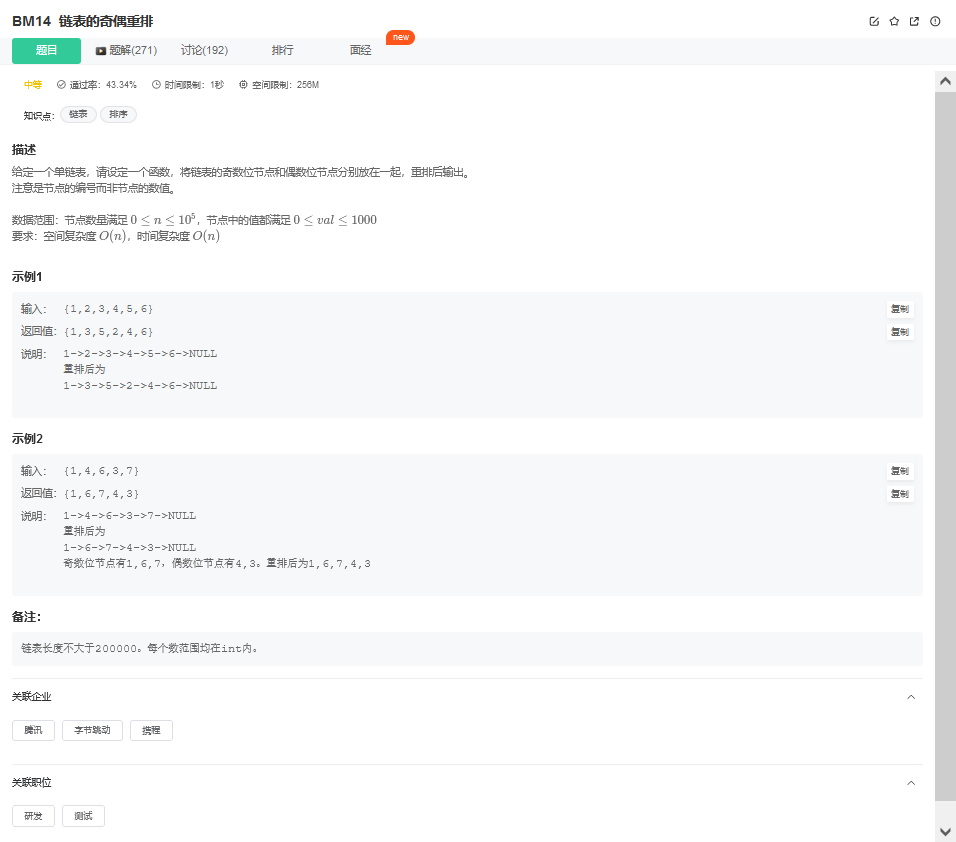
17.2. 解题思路
方法:双指针(推荐使用)

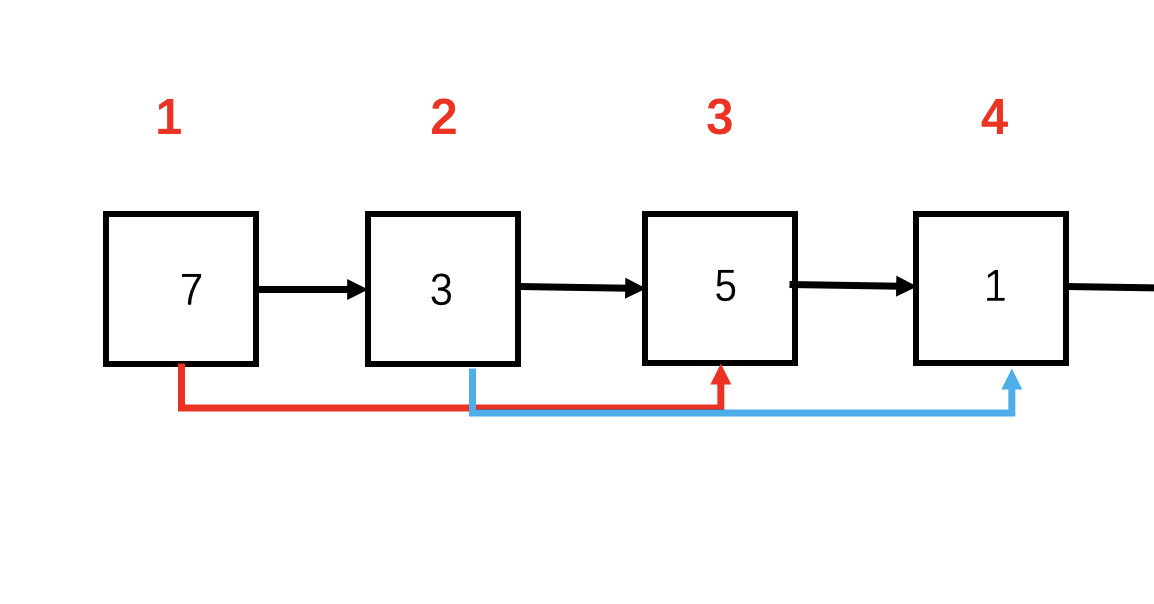
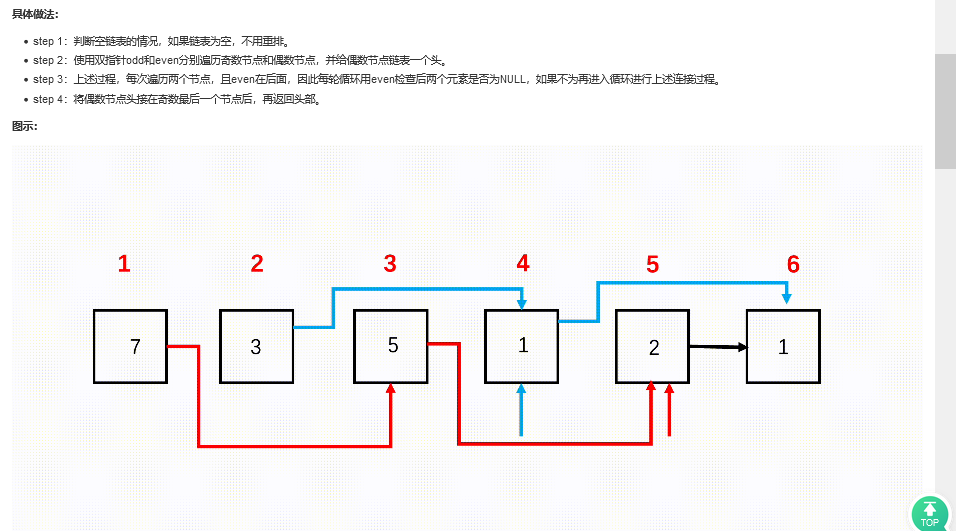
Java实现代码:
import java.util.*;
public class Solution {public ListNode oddEvenList (ListNode head) {//如果链表为空,不用重排if(head == null) return head;//even开头指向第二个节点,可能为空ListNode even = head.next; //odd开头指向第一个节点ListNode odd = head; //指向even开头ListNode evenhead = even; while(even != null && even.next != null){//odd连接even的后一个,即奇数位odd.next = even.next; //odd进入后一个奇数位odd = odd.next; //even连接后一个奇数的后一位,即偶数位even.next = odd.next; //even进入后一个偶数位even = even.next; } //even整体接在odd后面odd.next = evenhead; return head;}
}
18. 删除有序链表中重复的元素-I(简单)
18.1. 题目描述
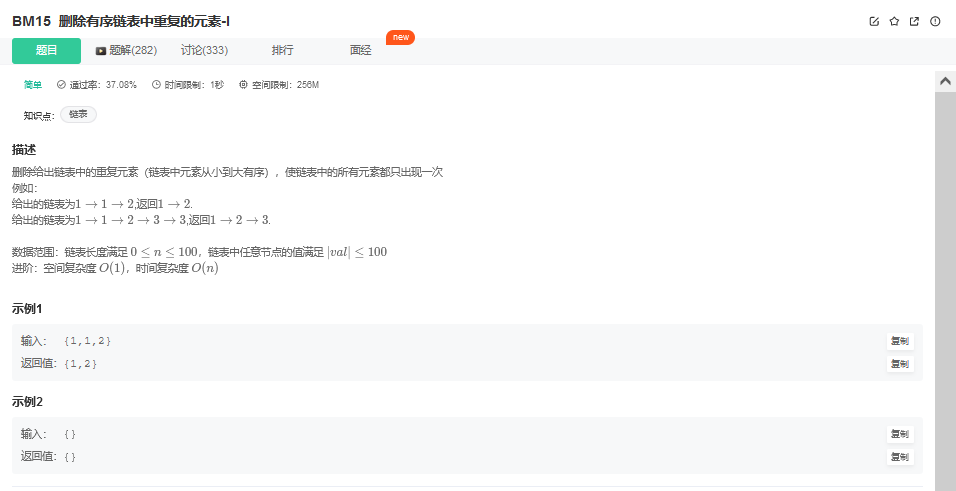
18.2. 解题思路
方法:遍历删除(推荐使用)


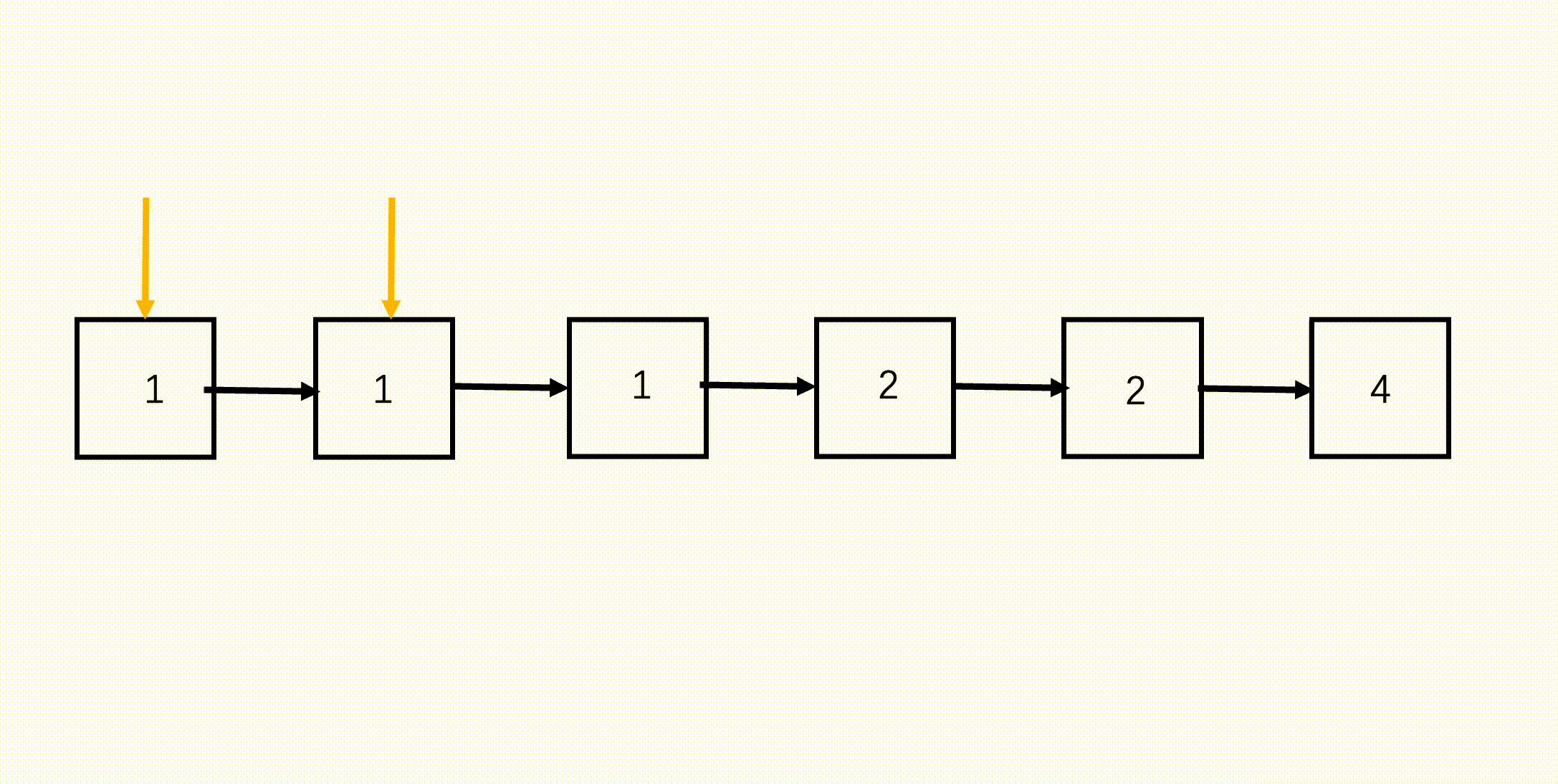
Java实现代码:
import java.util.*;
public class Solution {public ListNode deleteDuplicates (ListNode head) {//空链表if(head == null) return null;//遍历指针ListNode cur = head; //指针当前和下一位不为空while(cur != null && cur.next != null){ //如果当前与下一位相等则忽略下一位if(cur.val == cur.next.val) cur.next = cur.next.next;//否则指针正常遍历else cur = cur.next;}return head;}
}

19. 删除有序链表中重复的元素-II(中等)
19.1. 题目描述

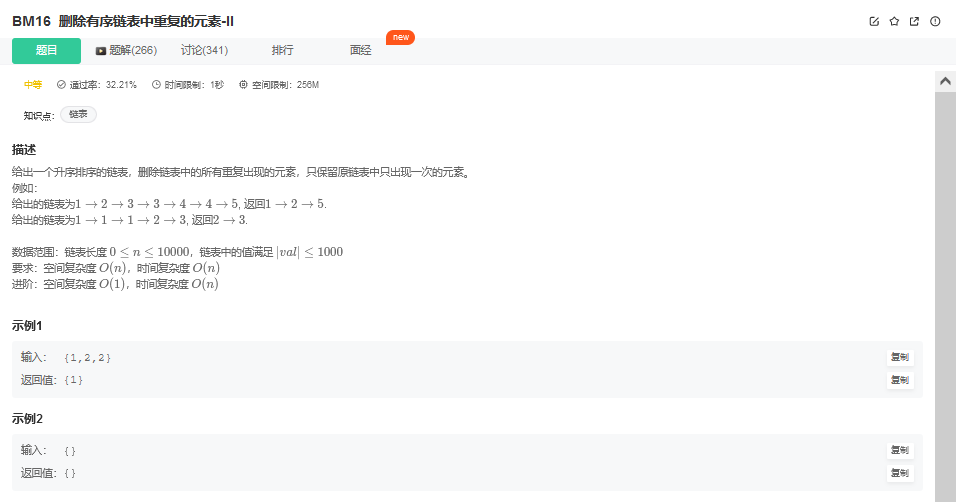

19.2. 解题思路
方法一:直接比较删除(推荐使用)
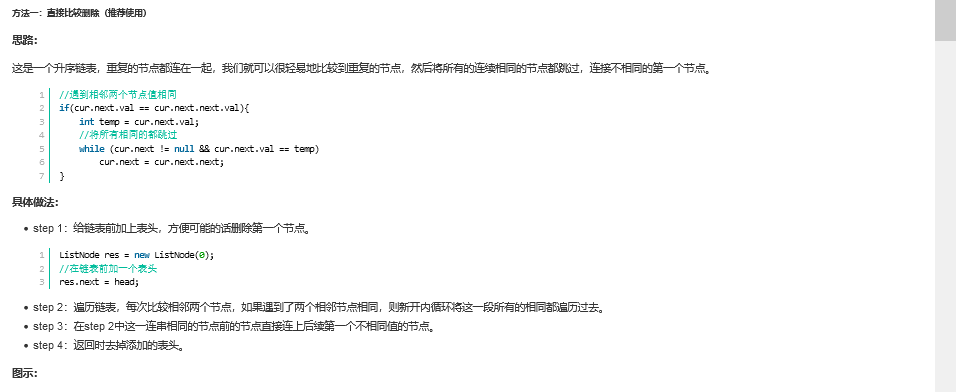

Java实现代码:
import java.util.*;
public class Solution {public ListNode deleteDuplicates (ListNode head) {//空链表if(head == null) return null;ListNode res = new ListNode(0);//在链表前加一个表头res.next = head; ListNode cur = res;while(cur.next != null && cur.next.next != null){ //遇到相邻两个节点值相同if(cur.next.val == cur.next.next.val){ int temp = cur.next.val;//将所有相同的都跳过while (cur.next != null && cur.next.val == temp) cur.next = cur.next.next;}else cur = cur.next;}//返回时去掉表头return res.next; }
}

方法二:哈希表(扩展思路)

Java实现代码:
import java.util.*;
public class Solution {public ListNode deleteDuplicates (ListNode head) {//空链表if(head == null) return null;Map<Integer,Integer> mp = new HashMap<>();ListNode cur = head;//遍历链表统计每个节点值出现的次数while(cur != null){ if(mp.containsKey(cur.val))mp.put(cur.val, (int)mp.get(cur.val) + 1);elsemp.put(cur.val,1);cur = cur.next;}ListNode res = new ListNode(0);//在链表前加一个表头res.next = head; cur = res;//再次遍历链表while(cur.next != null){//如果节点值计数不为1 if(mp.get(cur.next.val) != 1) //删去该节点cur.next = cur.next.next; elsecur = cur.next; }//去掉表头return res.next; }
}

20. 删除链表的中间节点(中等)
20.1. 题目描述
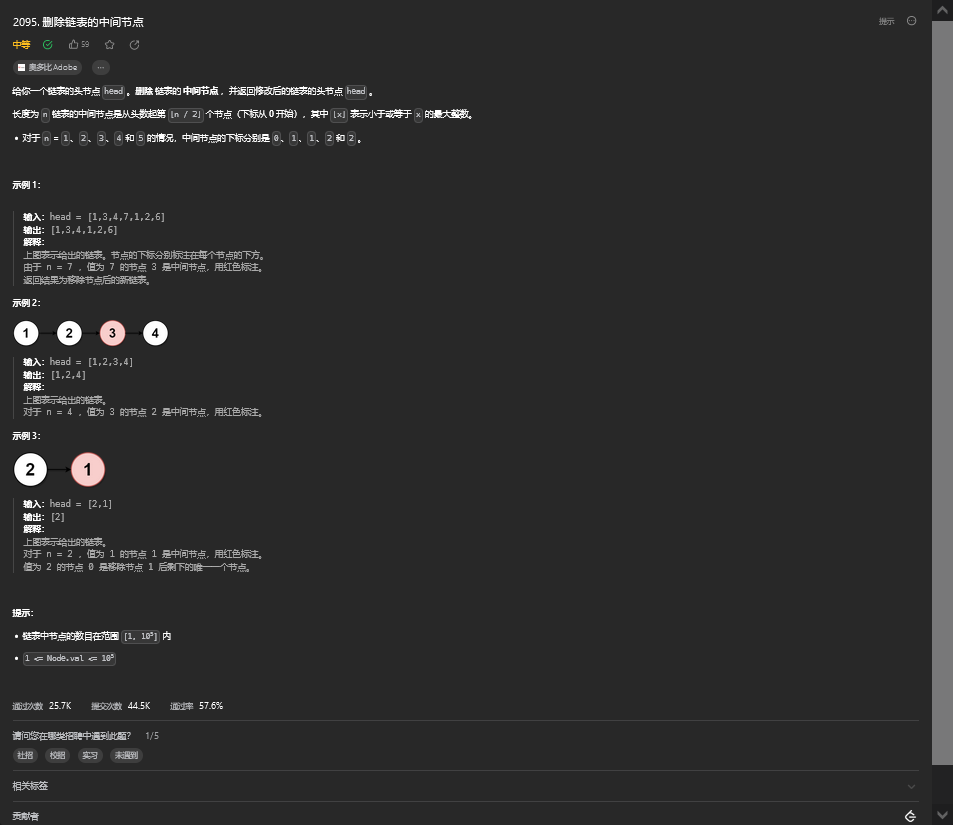
20.2. 解题思路
解题思路: 使用 slow 记录慢指针,fast 记录快指针。
当 fast 的再一次移动就结束时,说明 slow 的再一次移动也将到达中间点,
那么这个时候就可以直接用 slow.next = slow.next.next 来去掉中间节点。
方法一:快慢指针
class Solution {public ListNode deleteMiddle(ListNode head) {if (head == null || head.next == null) {return null;}ListNode slow = head;ListNode fast = head.next;while (fast.next != null && fast.next.next != null) {slow = slow.next;fast = fast.next.next;}slow.next = slow.next.next;return head;}
}21. 删除链表的倒数第n个节点(中等)
21.1. 题目描述
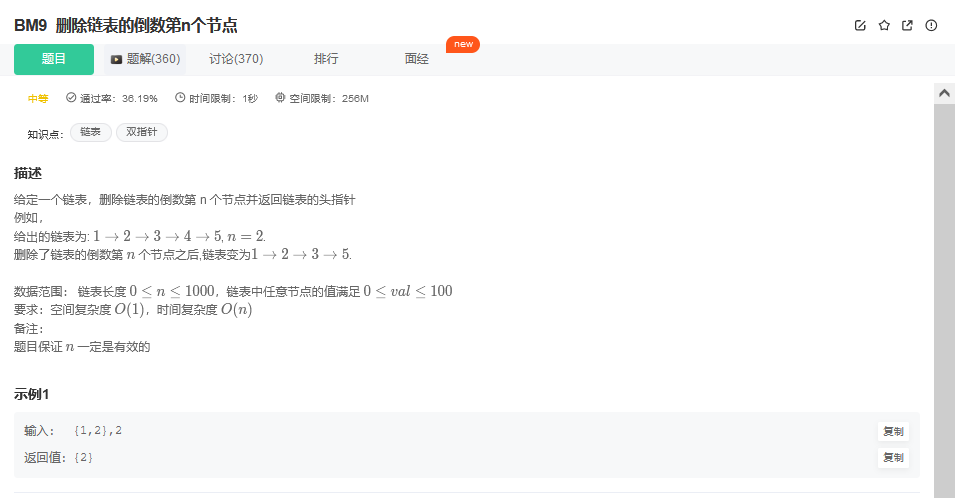
21.2. 解题思路
方法一:双指针(推荐使用)
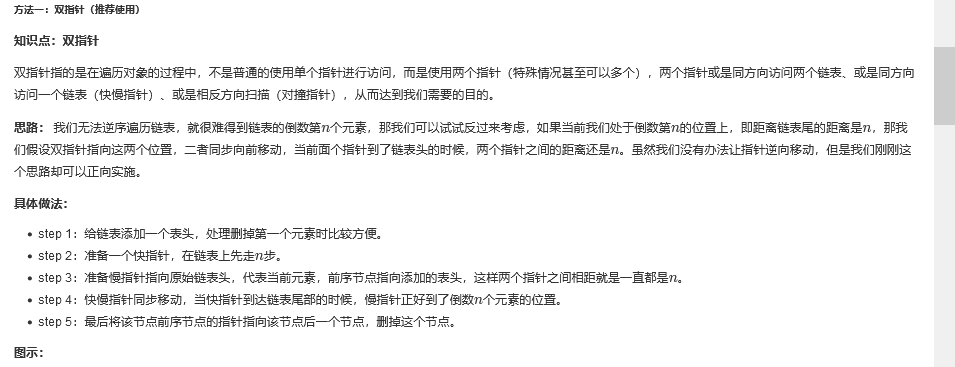
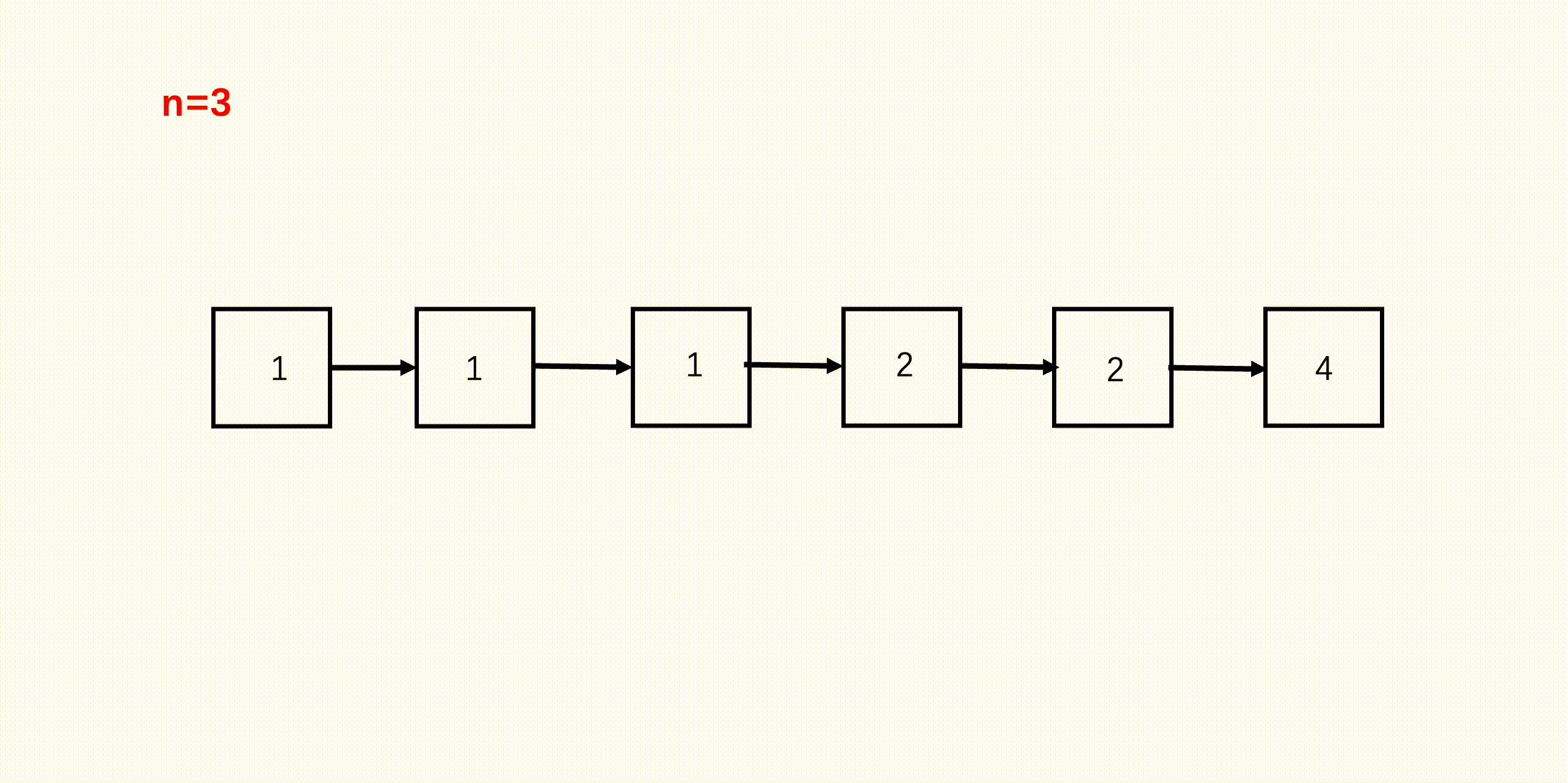
Java实现代码:
import java.util.*;
public class Solution {public ListNode removeNthFromEnd (ListNode head, int n) {//添加表头ListNode res = new ListNode(-1); res.next = head;//当前节点ListNode cur = head; //前序节点ListNode pre = res; ListNode fast = head;//快指针先行n步while(n != 0){ fast = fast.next;n--;}//快慢指针同步,快指针到达末尾,慢指针就到了倒数第n个位置while(fast != null){fast = fast.next;pre = cur;cur = cur.next;}//删除该位置的节点pre.next = cur.next; //返回去掉头return res.next; }
}

方法二:长度统计法(思路扩展)

Java实现代码:
import java.util.*;
public class Solution {public ListNode removeNthFromEnd (ListNode head, int n) {//记录链表长度int length = 0; //添加表头ListNode res = new ListNode(-1); res.next = head;//当前节点ListNode cur = head; //前序节点ListNode pre = res; //找到链表长度while(cur != null){ length++;cur = cur.next;}//回到头部cur = head; //从头遍历找到倒数第n个位置for(int i = 0; i < length - n; i++){ pre = cur;cur = cur.next;}//删去倒数第n个节点pre.next = cur.next; //返回去掉头节点return res.next; }
}

22. 从尾到头打印链表(简单)
22.1. 题目描述
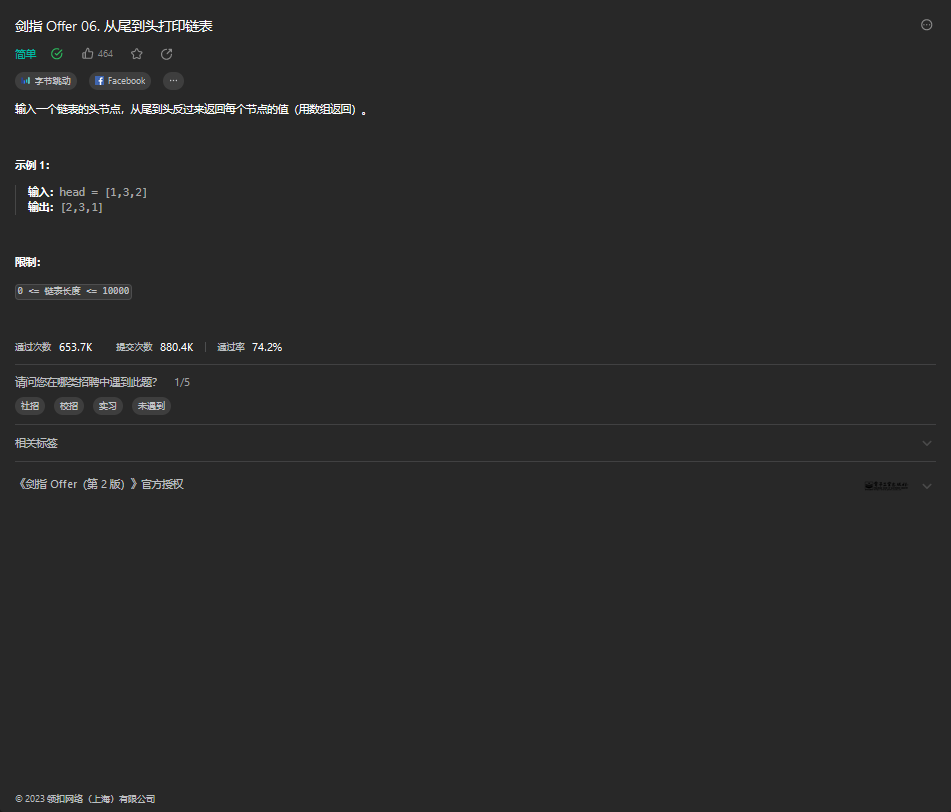
22.2. 解题思路
class Solution {public int[] reversePrint(ListNode head) {int count = 0; //链表结点的个数ListNode p = head;while(p != null){ //统计链表中结点的个数count++;p = p.next;}int[] ans = new int[count]; //创建一个和结点个数等大的数组p = head;int index = count - 1; //作为索引填充数组(从后往前填充)while(p != null){ans[index] = p.val;p = p.next;index--;}return ans;}
}23. 两两交换链表中的节点(中等)
23.1. 题目描述

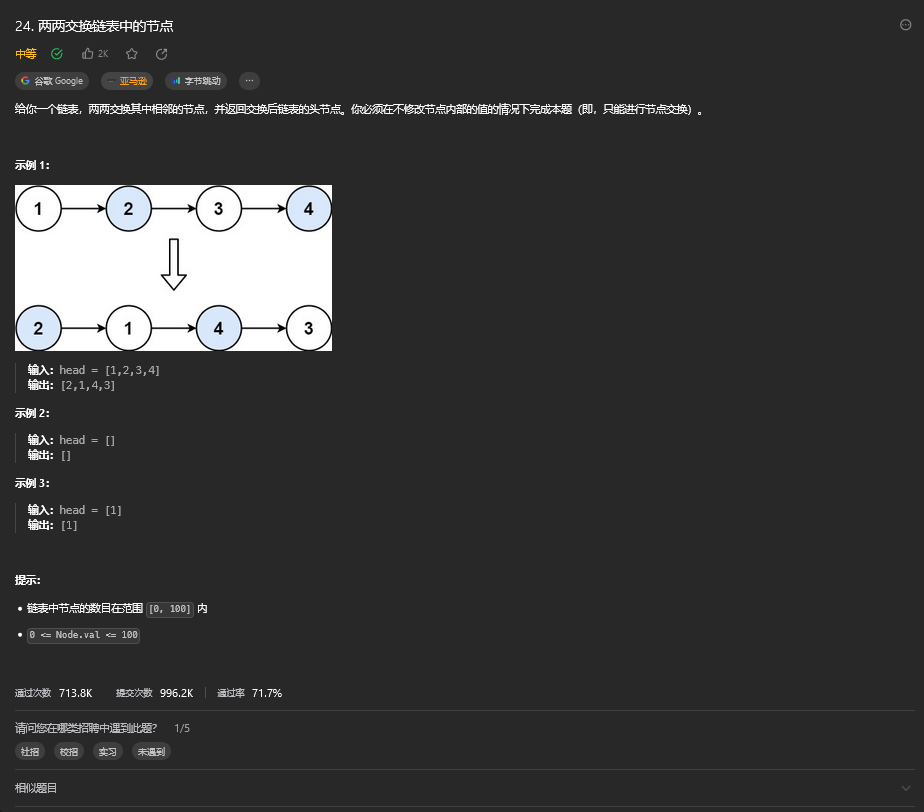
23.2. 解题思路
方法一:递归


class Solution {public ListNode swapPairs(ListNode head) {if (head == null || head.next == null) {return head;}ListNode newHead = head.next;head.next = swapPairs(newHead.next);newHead.next = head;return newHead;}
}

方法二:迭代

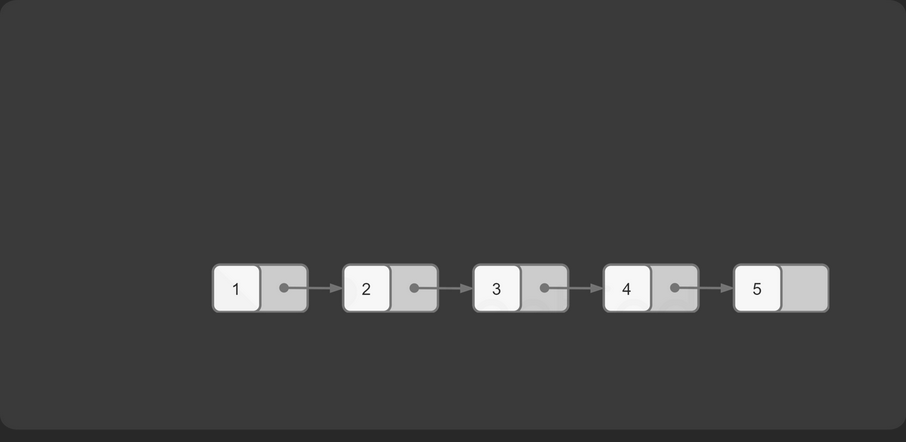
Java代码:
class Solution {public ListNode swapPairs(ListNode head) {ListNode dummyHead = new ListNode(0);dummyHead.next = head;ListNode temp = dummyHead;while (temp.next != null && temp.next.next != null) {ListNode node1 = temp.next;ListNode node2 = temp.next.next;temp.next = node2;node1.next = node2.next;node2.next = node1;temp = node1;}return dummyHead.next;}
}

24. 复制带随机指针的链表(中等)
24.1. 题目描述

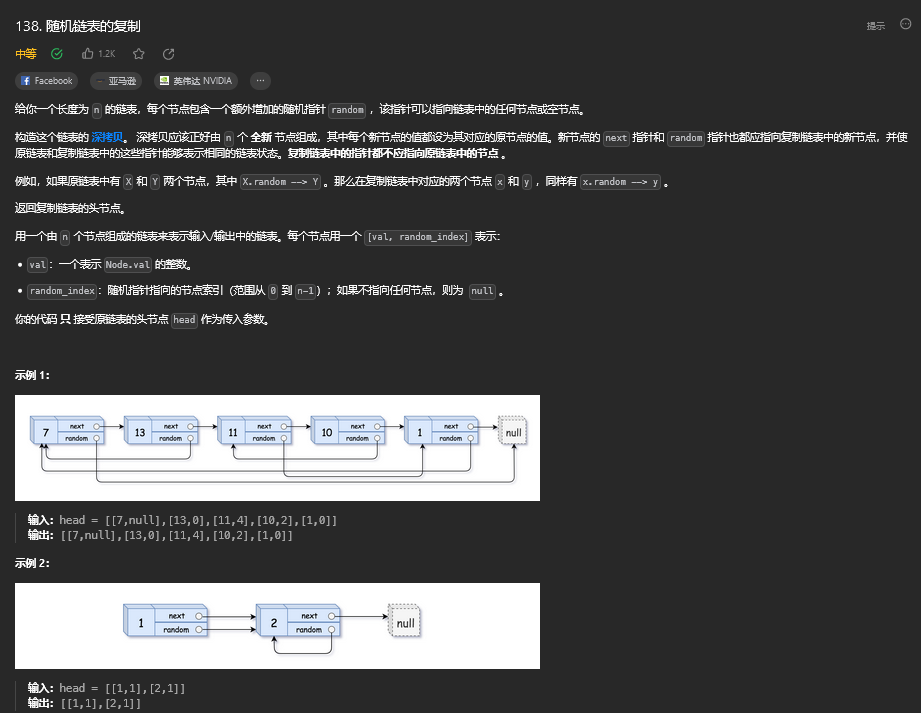
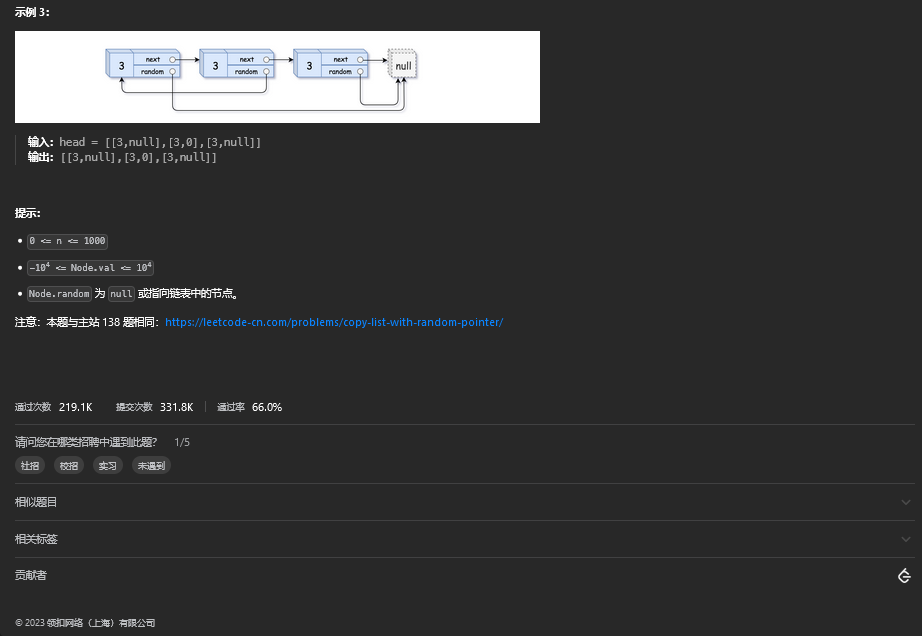
24.2. 解题思路
方法一:回溯 + 哈希表


Java代码:
class Solution {Map<Node, Node> cachedNode = new HashMap<Node, Node>();public Node copyRandomList(Node head) {if (head == null) {return null;}if (!cachedNode.containsKey(head)) {Node headNew = new Node(head.val);cachedNode.put(head, headNew);headNew.next = copyRandomList(head.next);headNew.random = copyRandomList(head.random);}return cachedNode.get(head);}
}

方法二:迭代 + 节点拆分




class Solution {public Node copyRandomList(Node head) {if (head == null) {return null;}for (Node node = head; node != null; node = node.next.next) {Node nodeNew = new Node(node.val);nodeNew.next = node.next;node.next = nodeNew;}for (Node node = head; node != null; node = node.next.next) {Node nodeNew = node.next;nodeNew.random = (node.random != null) ? node.random.next : null;}Node headNew = head.next;for (Node node = head; node != null; node = node.next) {Node nodeNew = node.next;node.next = node.next.next;nodeNew.next = (nodeNew.next != null) ? nodeNew.next.next : null;}return headNew;}
}

25. 链表最大孪生和(中等)
25.1. 题目描述

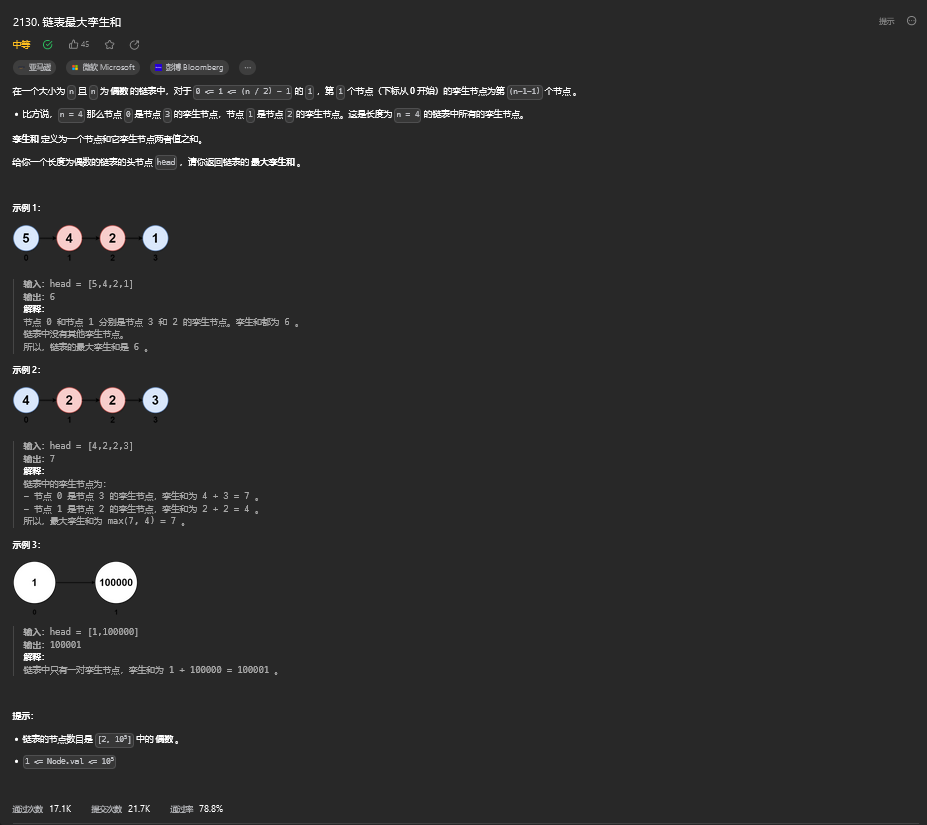
25.2. 解题思路
快慢指针+ 翻转链表(头部翻转)
传统方法:
- 先使用快慢指针找到中间节点 Using the Fast& Slow pointers to Find the middle point
- 翻转第二部分 Reverse the secondPart
- 通过同时遍历第一部分与反转后的第二部分得出最大结果 Add the values and store the maximum value
具体代码如下:
class Solution {public int pairSum(ListNode head) {ListNode fast = head;ListNode slow = head;while (fast != null && fast.next != null) {fast = fast.next.next;slow = slow.next;}ListNode prev = reverse(slow);ListNode head1 = head, head2 = prev;int res = 0;while (head2 != null) {res = Math.max(head1.val + head2.val, res);head1 = head1.next;head2 = head2.next;}return res;}private ListNode reverse(ListNode head) {if (head == null || head.next == null) {return head;}ListNode curr = head;ListNode prev = null;while (curr != null) {ListNode next = curr.next;curr.next = prev;prev = curr;curr = next;}return prev;}
}对原有思路进行改进:
可以在使用快慢指针时同时对第一部分(前一半)链表进行翻转操作 相较于原先 找到中间节点后翻转第二部分 更加简洁快速
具体代码如下:
class Solution {public int pairSum(ListNode head) {ListNode fast = head;ListNode slow = head;ListNode prev = null;while (fast != null && fast.next != null) {fast = fast.next.next;ListNode next = slow.next;slow.next = prev;prev = slow;slow = next;}int res = 0;while (slow != null) {res = Math.max(res, prev.val + slow.val);prv = prev.next;slow = slow.next;}return res;}}相关文章:

数据结构与算法篇(刷题篇 - 链表)
目录 1. 反转链表(简单) 1.1. 题目描述 1.2. 解题思路 方法一:迭代(推荐使用) 方法二:递归(扩展思路) 方法三:使用栈解决 方法四:双链表求解 2. 链表内…...

TinyAgent: 从零开始构建最小化Agent系统
引言 随着大模型(LLM)的崛起,特别是ChatGPT等大模型的广泛应用,基于LLM的系统越来越受欢迎。然而,尽管大模型具备强大的生成能力和推理能力,它们在处理某些专有领域或实时问题时仍然存在局限性。因此&#…...
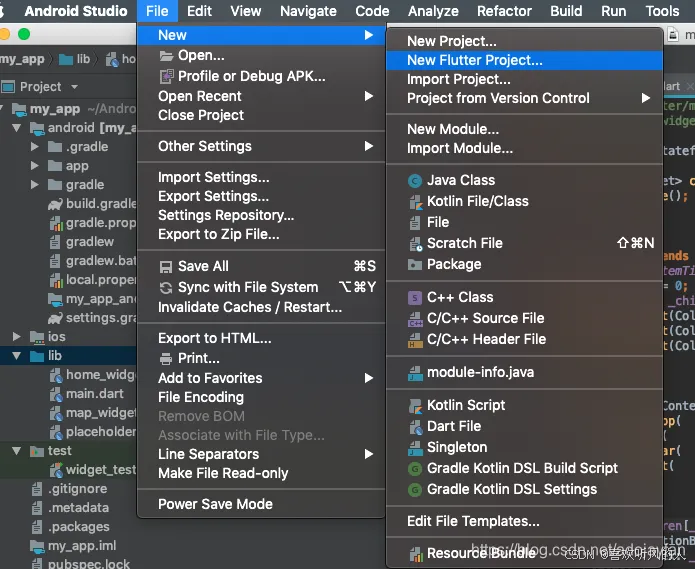
Android Studio New里面没有New Flutter Project
跟着Flutter中文网的配置教程,安装好了flutter,在Android studio里面也安装了dart和flutter的插件。重启后还是在FIle->New里面没有显示New Flutter Project。 反复卸载重装dart和flutter插件好几次,依然没有效果。 原来是没有把Android APK Suppor…...

linux信号 | 学习信号四步走 | 透析信号是如何被处理的?
前言:本节内容讲述linux信号的捕捉。 我们通过前面的学习, 已经学习了信号的概念, 信号的产生, 信号的保存。 只剩下信号的处理。 而信号的处理我们应该着重注意的是第三种处理方式——信号的捕捉。 也就是说, 这篇文章…...
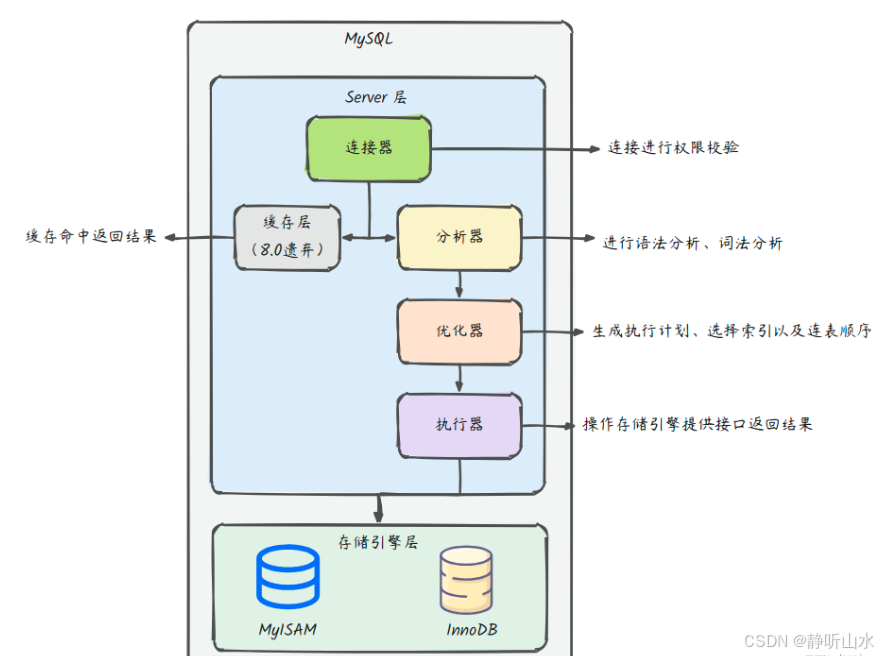
mysql语句执行过程
具体流程如下: 1】当客户端的SOL发送到MySQL时,首先是到达服务器层的连接器,连接器会对你此次发起的连接进行权限校验,以此来获取你这个账号拥有的权限。当你的账号或密码不正确时,会报用户错误。连接成功如果后续没有任何操作&am…...

最新版本SkyWalking【10.1.0】部署
这里写目录标题 前言前置条件启动Skywalking下载解压启动说明 集成Skywalking Agent下载Agent在IDEA中添加agent启动应用并访问SpringBoot接口 说明 前言 基于当前最新版10.1.0搭建skywalking 前置条件 装有JDK11版本的环境了解SpringBoot相关知识 启动Skywalking 下载 地…...

WSL2 中配置桥接模式、虚拟交换机及固定 IP
WSL2 中配置桥接模式、虚拟交换机及固定 IP 一、创建虚拟交换机1.1 使用 Hyper-V 管理器创建虚拟交换机1.2 使用 PowerShell 创建虚拟交换机 二、更新 WSL 配置三、设置 WSL2 中的静态 IP、网关和 DNS3.1 编辑网络配置文件3.2 应用网络配置3.3 测试网络连接 四、重启 WSL 在使用…...

Unite Shanghai 2024 团结引擎专场 | 团结引擎 OpenHarmony 工程剖析
在 2024 年 7 月 24 日的 Unite Shanghai 2024 团结引擎专场演讲中,Unity中国 OpenHarmony 技术负责人刘伟贤对团结引擎导出的 OpenHarmony 工程进行了细节剖析,详细讲解 XComponent 如何与引擎结合,UI 线程和引擎线程的关联以及 ts/ets 的代…...
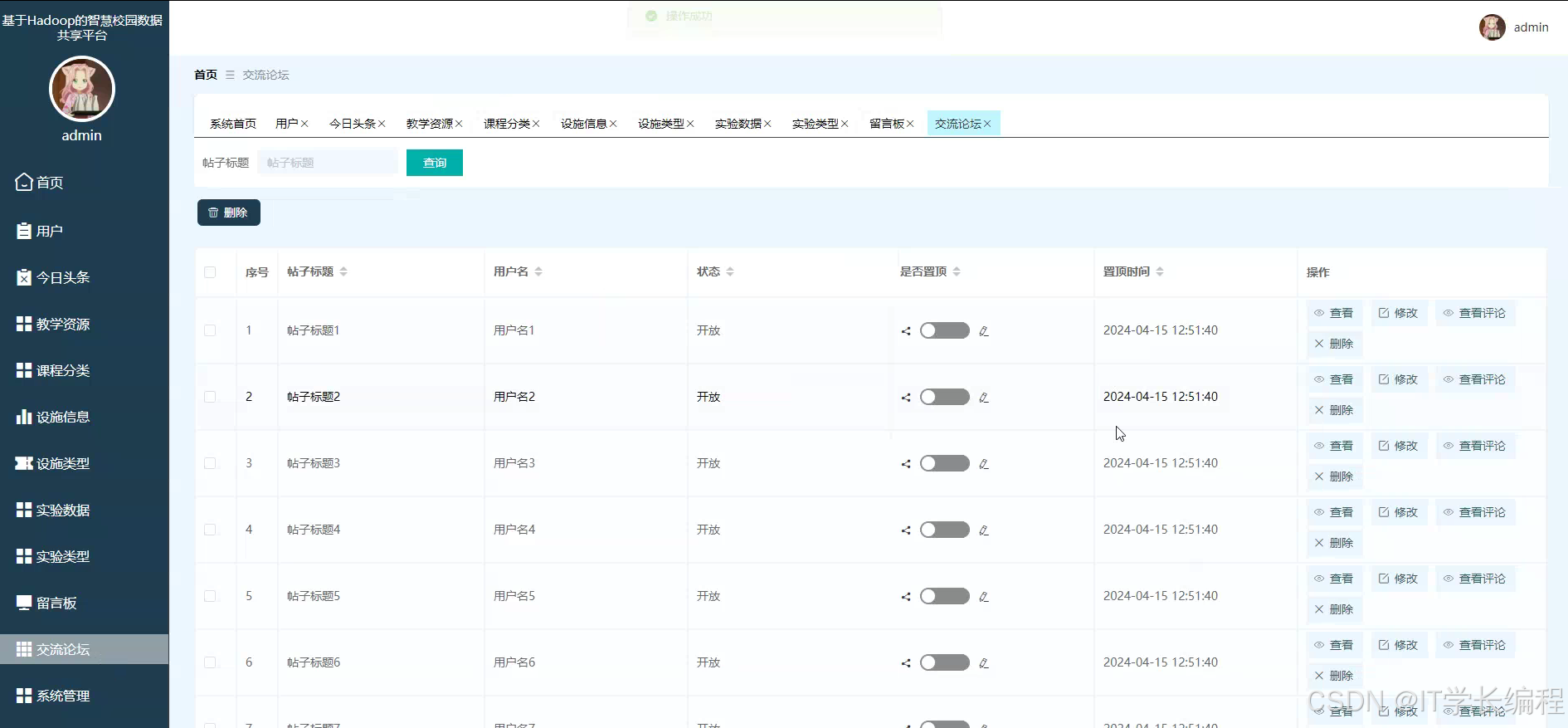
计算机毕业设计 基于Hadoop的智慧校园数据共享平台的设计与实现 Python毕业设计 Python毕业设计选题 Spark 大数据【附源码+安装调试】
博主介绍:✌从事软件开发10年之余,专注于Java技术领域、Python人工智能及数据挖掘、小程序项目开发和Android项目开发等。CSDN、掘金、华为云、InfoQ、阿里云等平台优质作者✌ 🍅文末获取源码联系🍅 👇🏻 精…...
)
2022CCPC绵阳站VP题解报告(CGHMAE六题)
文章目录 2022CCPC绵阳站VP题解报告前言[Problem - C ](https://codeforces.com/gym/104065/problem/C) (签到思维)[H (codeforces.com)](https://codeforces.com/gym/104065/problem/H) (签到构造)[Problem - G ](https://codefo…...

代码随想录day23:贪心part1
455. 分发饼干 class Solution {public int findContentChildren(int[] g, int[] s) {Arrays.sort(g);Arrays.sort(s);int res 0;int index s.length - 1;for(int i g.length - 1; i > 0; i--){if(index > 0 && s[index] > g[i]){res;index--;}}return r…...

通过网页设置参数,submit还是json
在通过网页设置参数并发送到服务器时,选择使用submit(通常是通过HTML表单的提交)还是直接发送JSON数据(通常是通过AJAX请求,如使用fetch API)取决于几个因素,包括你的服务器端如何处理这些请求、…...
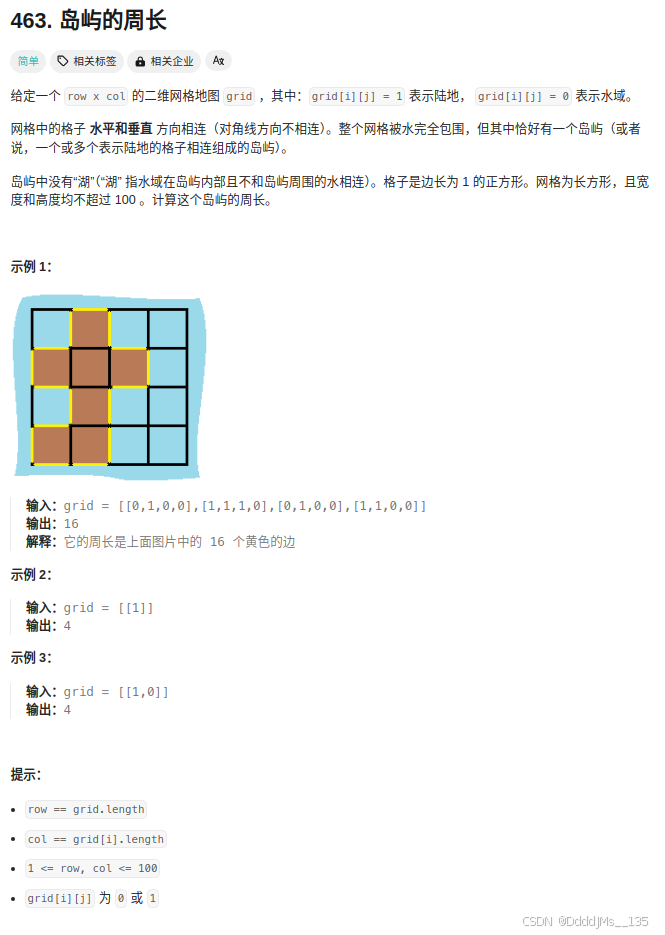
C语言 | Leetcode C语言题解之第463题岛屿的周长
题目: 题解: const int dx[4] {0, 1, 0, -1}; const int dy[4] {1, 0, -1, 0};int dfs(int x, int y, int** grid, int n, int m) {if (x < 0 || x > n || y < 0 || y > m || grid[x][y] 0) {return 1;}if (grid[x][y] 2) {return 0;}g…...

逼近理论及应用精解【12】
文章目录 卷积卷积层与滤波层定义数学原理与公式定理架构例子例题 卷积层和滤波层概念的详细解释卷积层滤波层 滤波层和卷积层在卷积神经网络(CNN)中区别滤波层卷积层总结卷积层的数学原理滤波层的数学原理 参考文献 卷积 卷积层与滤波层 定义 卷积层…...

LIN总线学习大全(基于CANoe和CAPL)
🍅 我是蚂蚁小兵,专注于车载诊断领域,尤其擅长于对CANoe工具的使用🍅 寻找组织 ,答疑解惑,摸鱼聊天,博客源码,点击加入👉【相亲相爱一家人】🍅 玩转CANoe&…...
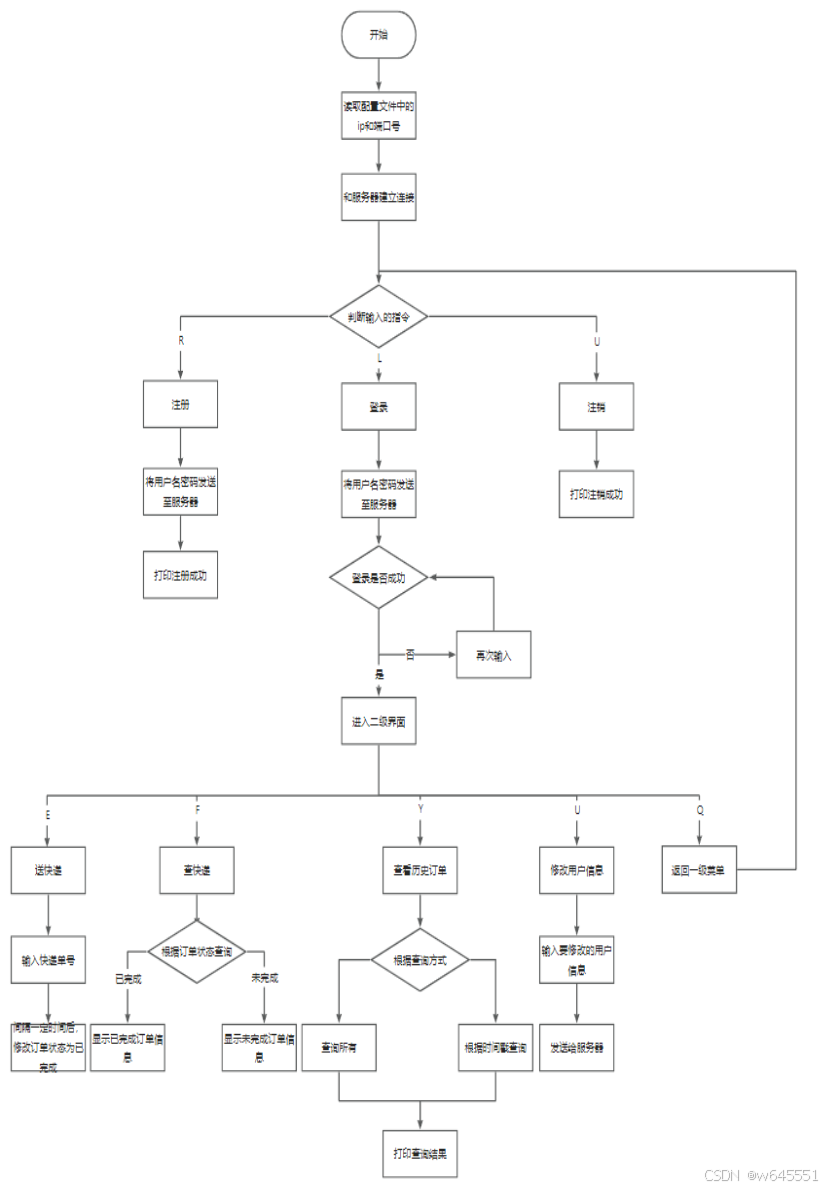
国庆作业
day1 1.开发环境 Linux系统GCCFDBmakefilesqlite3 2.功能描述 项目功能: 服务器:处理客户端的请求,并将数据存入数据库中,客户端请求的数据从数据库进行获取,服务器转发给客户端。 用户客户端:实现账号的注册、登…...
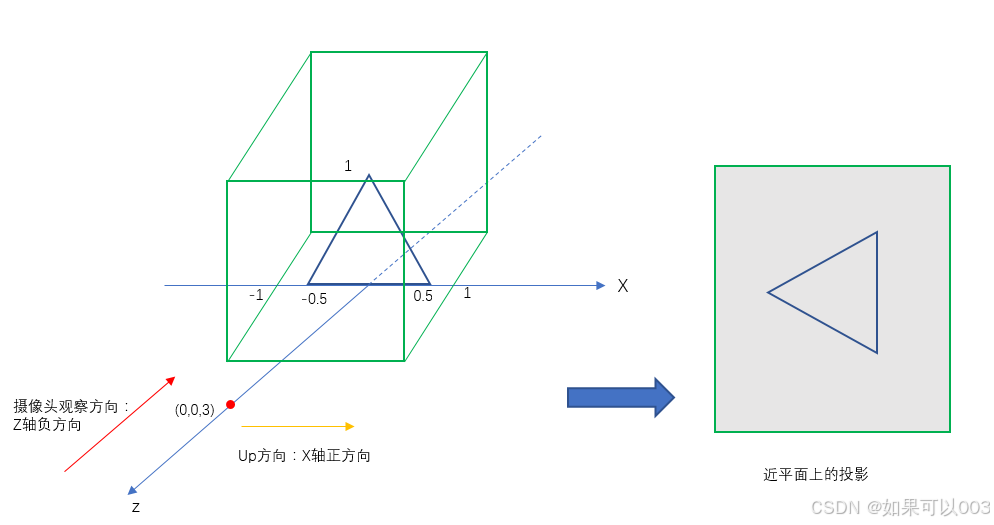
Android OpenGLES2.0开发(四):矩阵变换和相机投影
事物的本质是事物本身所固有的、深藏于现象背后并决定或支配现象的方面。 还记得我们上一篇绘制的三角形吗,我们确实能够顺利用OpenGL ES绘制出图形了,这是一个好的开始,但这还远远不够。我们定义的坐标是正三角形,但是绘制出…...

快递查询软件:实现单号识别与批量物流查询的高效工具
随着网络购物的普及,快递物流行业迎来了前所未有的发展机遇,同时也面临着巨大的挑战。跟踪物流信息成为一个难题,因此,快递查询软件的核心功能之一便是单号识别。传统的快递单号输入方式繁琐且易出错在此背景下,快递查…...
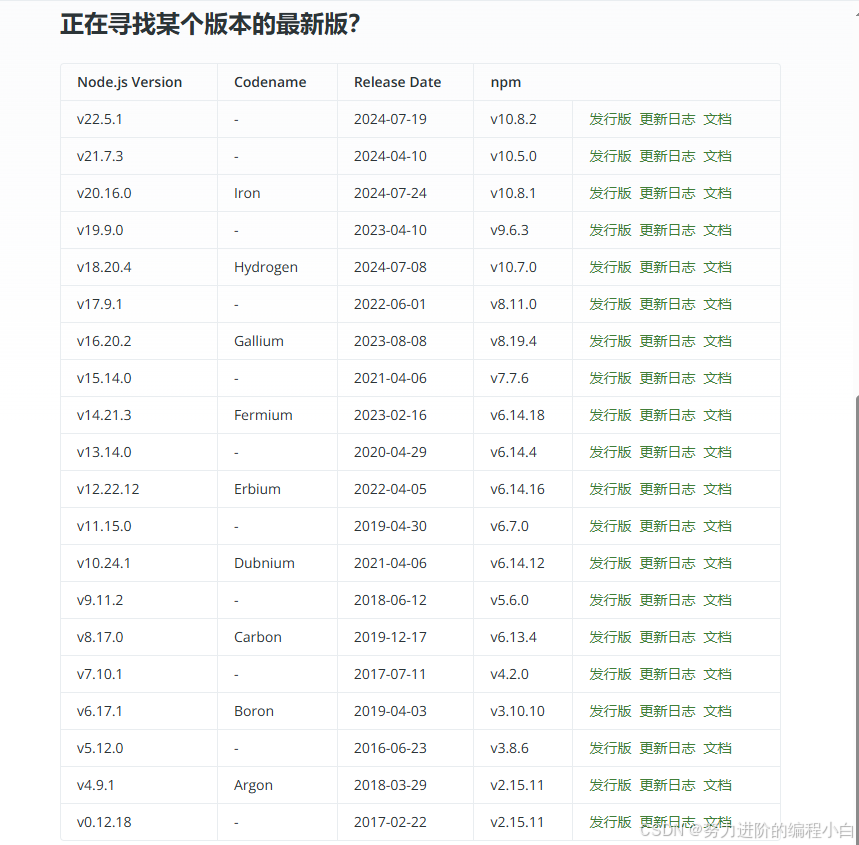
nodejs与npm版本对应表
Node.js — Node.js 版本 (nodejs.org)...

Spring Boot 项目中如何使用异步任务
前置知识: 同步任务: 同步任务是在单线程中按顺序执行,每次只有一个任务在执行,不会引发线程安全和数据一致性等并发问题 同步任务需要等待任务执行完成后才能执行下一个任务,无法同时处理多个任务,响应慢…...

为什么需要建设工程项目管理?工程项目管理有哪些亮点功能?
在建筑行业,项目管理的重要性不言而喻。随着工程规模的扩大、技术复杂度的提升,传统的管理模式已经难以满足现代工程的需求。过去,许多企业依赖手工记录、口头沟通和分散的信息管理,导致效率低下、成本失控、风险频发。例如&#…...

什么是库存周转?如何用进销存系统提高库存周转率?
你可能听说过这样一句话: “利润不是赚出来的,是管出来的。” 尤其是在制造业、批发零售、电商这类“货堆成山”的行业,很多企业看着销售不错,账上却没钱、利润也不见了,一翻库存才发现: 一堆卖不动的旧货…...

Android 之 kotlin 语言学习笔记三(Kotlin-Java 互操作)
参考官方文档:https://developer.android.google.cn/kotlin/interop?hlzh-cn 一、Java(供 Kotlin 使用) 1、不得使用硬关键字 不要使用 Kotlin 的任何硬关键字作为方法的名称 或字段。允许使用 Kotlin 的软关键字、修饰符关键字和特殊标识…...

学习STC51单片机32(芯片为STC89C52RCRC)OLED显示屏2
每日一言 今天的每一份坚持,都是在为未来积攒底气。 案例:OLED显示一个A 这边观察到一个点,怎么雪花了就是都是乱七八糟的占满了屏幕。。 解释 : 如果代码里信号切换太快(比如 SDA 刚变,SCL 立刻变&#…...

【C++特殊工具与技术】优化内存分配(一):C++中的内存分配
目录 一、C 内存的基本概念 1.1 内存的物理与逻辑结构 1.2 C 程序的内存区域划分 二、栈内存分配 2.1 栈内存的特点 2.2 栈内存分配示例 三、堆内存分配 3.1 new和delete操作符 4.2 内存泄漏与悬空指针问题 4.3 new和delete的重载 四、智能指针…...

虚拟电厂发展三大趋势:市场化、技术主导、车网互联
市场化:从政策驱动到多元盈利 政策全面赋能 2025年4月,国家发改委、能源局发布《关于加快推进虚拟电厂发展的指导意见》,首次明确虚拟电厂为“独立市场主体”,提出硬性目标:2027年全国调节能力≥2000万千瓦࿰…...

Web中间件--tomcat学习
Web中间件–tomcat Java虚拟机详解 什么是JAVA虚拟机 Java虚拟机是一个抽象的计算机,它可以执行Java字节码。Java虚拟机是Java平台的一部分,Java平台由Java语言、Java API和Java虚拟机组成。Java虚拟机的主要作用是将Java字节码转换为机器代码&#x…...

R 语言科研绘图第 55 期 --- 网络图-聚类
在发表科研论文的过程中,科研绘图是必不可少的,一张好看的图形会是文章很大的加分项。 为了便于使用,本系列文章介绍的所有绘图都已收录到了 sciRplot 项目中,获取方式: R 语言科研绘图模板 --- sciRplothttps://mp.…...
 Module Federation:Webpack.config.js文件中每个属性的含义解释)
MFE(微前端) Module Federation:Webpack.config.js文件中每个属性的含义解释
以Module Federation 插件详为例,Webpack.config.js它可能的配置和含义如下: 前言 Module Federation 的Webpack.config.js核心配置包括: name filename(定义应用标识) remotes(引用远程模块࿰…...

【Veristand】Veristand环境安装教程-Linux RT / Windows
首先声明,此教程是针对Simulink编译模型并导入Veristand中编写的,同时需要注意的是老用户编译可能用的是Veristand Model Framework,那个是历史版本,且NI不会再维护,新版本编译支持为VeriStand Model Generation Suppo…...
